Nikon Rangefinder Cameras
- Start of Camera Production
- The Release of Nikon Camera
- Strict Eye for Inspection
- Nikon and Nikkor in the Spotlight
- Development of Nikon S2
- Release of the Highest-Class Camera Nikon SP
- Release of Nikon S3 / S4 / S3M
- Release of Fisheye Camera
Start of Camera Production
Policy of Camera Manufacturing and Basic Research
The reason why the "Camera Special Commission" of the "Consumers Goods Production Subcommittee" of Nippon Kogaku K.K. proposed the production of a camera was chiefly due to the following expectation:, "a big demand can be expected if we make a reasonably-priced camera" and "since data for the necessary photographic lens had been collected since approximately 1945, such a camera can be produced for sale in a short time."
However, although Nippon Kogaku had experienced manufacturing aerial cameras and 3m / 2 m / 5m telescope cameras, it was the first experience to manufacture a high-class consumer camera. Therefore it was aimed to make a high-class product, it was decided that the camera will be the future subject of study.
However, there was a lot of enthusiasm for the camera among officers and men of the allied occupation troop, and as the U.S. demand for cameras as export goods became reality, Nippon Kogaku hastily decided to urge the production of camera.
At the board of directors meeting in October 1945, binoculars, photographic lenses and eyeglass lenses were designated as production items for one year from January 1946, and the camera was decided as the item to be produced next.
At the same time, designers who were engaged in the design of mechanical computers were designated as camera designers and were ordered to start studying.
In November, 1945, both the "Camera Special Commission" and "the (Slide) Projector Special Commission" were reorganized to become the "Camera and Projector Committee", which started the study of camera production.
The Designing Department immediately started the study of the camera's body construction.
The Research Department which was reorganized in November 1945 started the study of the camera body and the shutter mechanism, while the Designing Department proceeded in parallel with the shutter-speed test and the exposure meter as well as fundamental studies such as metal material and painting.
In April, 1946, the "Camera and Projector Committee" concluded the following :
Cameras to be manufactured by the company were:
- A twin-lens reflex (TLR) camera (lens 80 mm f/3.5, using 120 format film, 6 x 6 cm format 12 frames), and
- An universal type small-size camera (using 35mm(135 format) film, 24 x 32 mm format 40 frames),
Both of them were to be of the highest quality.
It was decided that the first order of priority was to be given to the TLR camera.
The design specifications of the small-size camera needed to introduce the advantages of the "Leica" and "Contax" models. These models were dividing the world of photography as the highest--class models available:, however, the camera could not be a duplicate of either of the two. Therefore, the standards were set bearing in mind that it had to be a 35mm focal-plane shutter camera which complied with the technical conscience of Nippon Kogaku. Its feature would be a picture size of 24 x 32 mm format.
The reasons to adopt the 24 x 32 mm format were:
- 1.The 3:4 proportion seemed to have better proportions than the "Leica" format (2:3).
- 2.It could take 40 frames and was more economical than the "Leica" format of 36 frames.
- 3.The standard of the slide projector provided by the Japanese Ministry of Education was 24 x 32 mm.
It was decided according to the basic idea of adopting our original picture size, which differed from that of the "Leica".
Due to anticipted improvements for enlargers, the idea that the camera could become even smaller in the future was foreseen. Some proposed the "Tenax" format (24 x 24 mm).
As the method of lens exchange, the bayonet fixing method ("Contax" type) was adopted for its rapid and easy attaching and detaching.
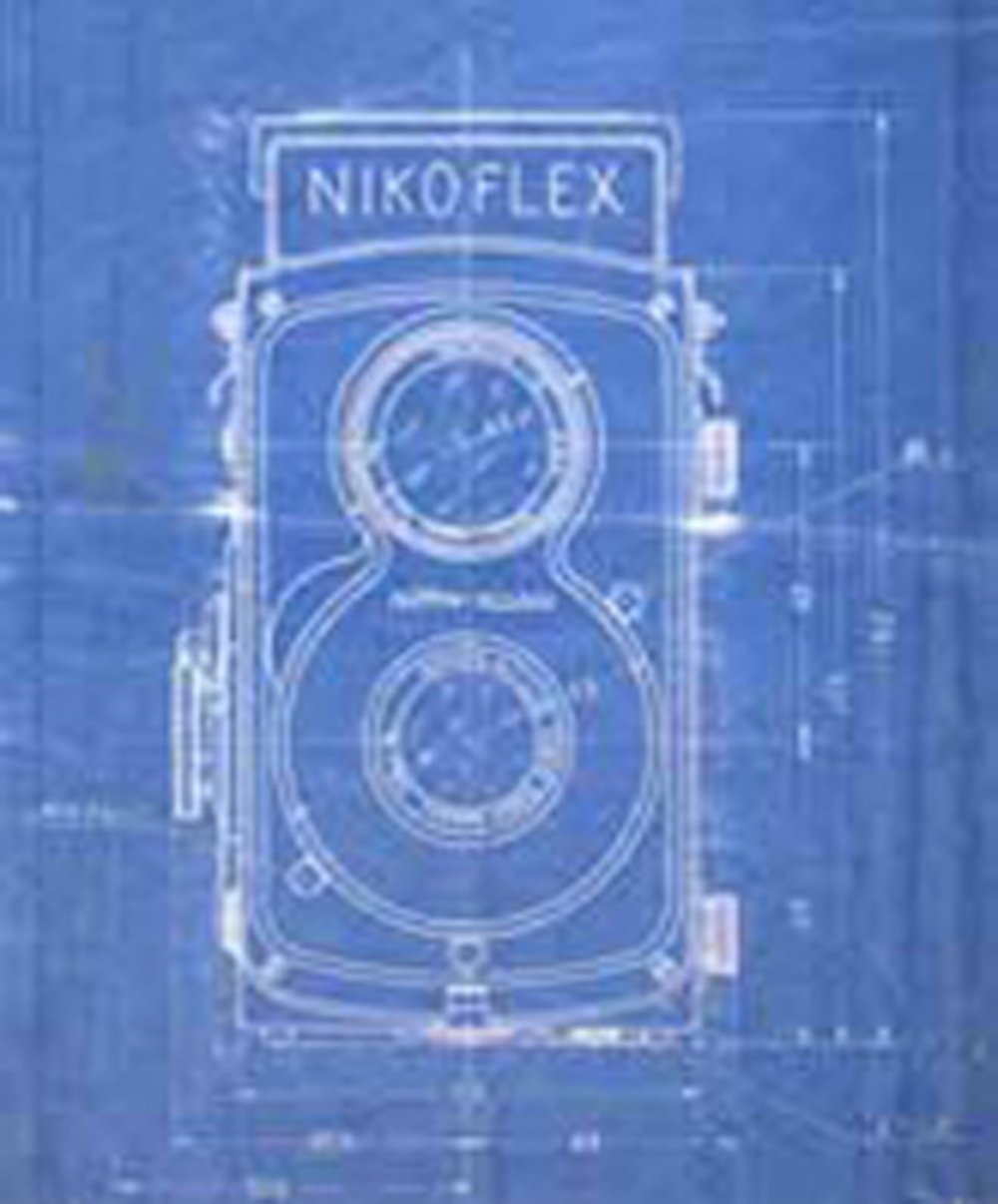
In April, 1946, when the production items and their specifications were decided, the "Camera and Projector Committee" was reorganized and the "Camera Committee" was newly established. It consisted of members from the Research Department, Designing Department and Production Engineering Department. This committee was to proceed with production planning.
The Research Department and Designing Department, in their mutual collaboration, proceeded the design and test of two models of camera bodies. On July 25, the anniversary of the company founding, mock-ups of a TLR camera and small-size camera were exhibited.
In the designing and prototyping stage, the TLR went ahead, but a problem with its lens shutter was left unsettled.
The Pronter type shutter on the market didn't meet with our standards of durability and accuracy. Therefore the company decided to produce a high-class Compur type shutter inside the company. Unfortunately, it turned out that the press tools were extremely expensive.
Subsequently, it was decided that development of the TLR should be suspended, and concentration should be placed on the 35mm(135 format) camera.
Incidentally, the production of the TLR camera was abandoned, due to the success of the 35mm camera.
Development of the Small-Sized Camera and the Nikon Brand
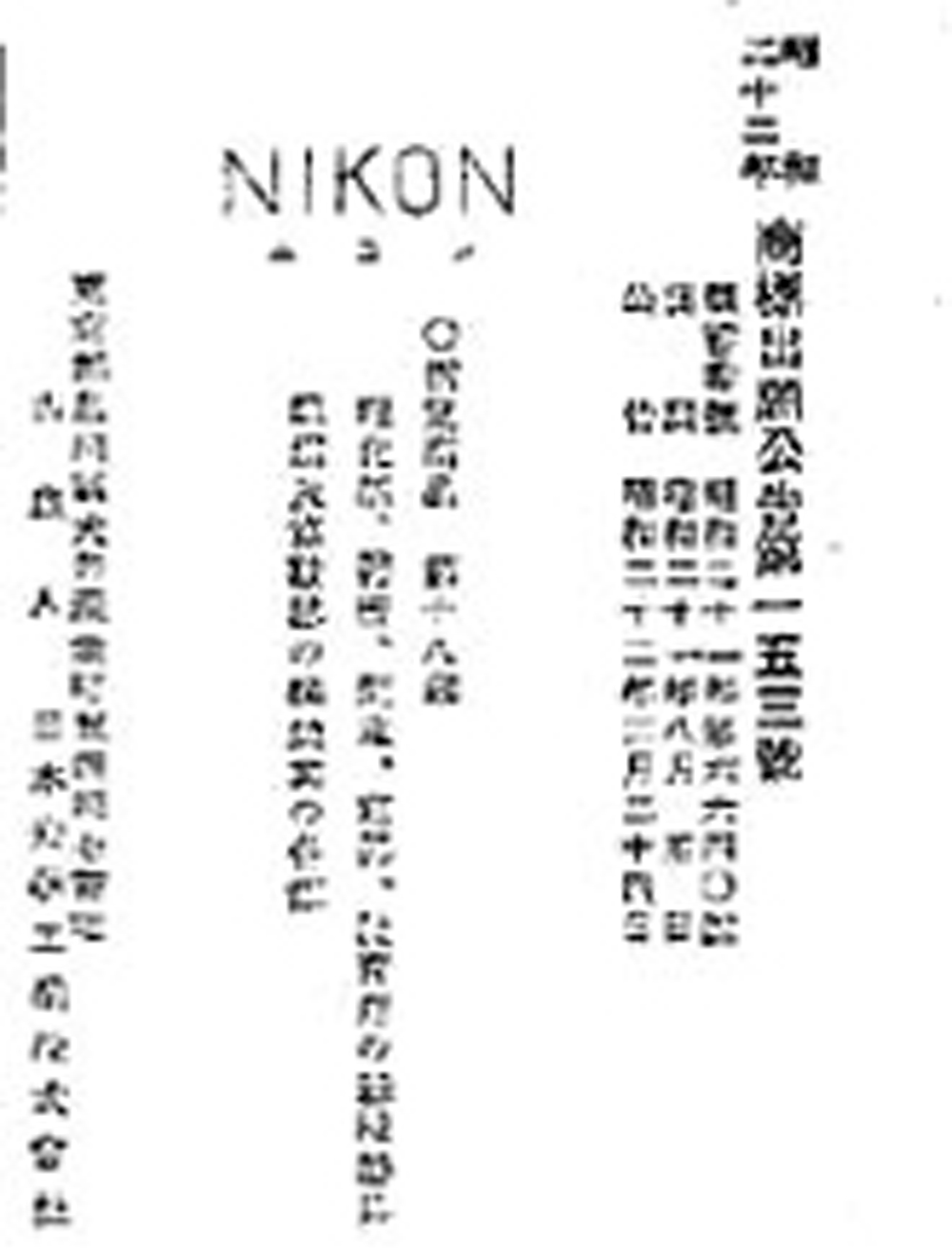
The first production order of small-sized cameras was issued in June 1946, two months after the specifications had been finalized. In July, the "Camera Work-shop Construction Committee" proposed the equipment and facility planning that was necessary for the Camera Workshop.
Further, at the meeting of the board of directors in August, an extremely short-term development schedule was agreed upon by mutual consent The prototyping would be finished in December, and the new product would be completed at the end of February, 1947.
Around 1946, there was a large demand for Japanese-made cameras. The demand was estimated to reach 170,000 pieces, mainly consisting of orders from CPO and planned reserves for collateral export in return for imported goods whici included food goods.
On the other hand, the production capacity for camera manufacturering was not yet sufficient. Production capability could only meet one third of the demand.
In response to this situation, Nippon Kogaku decided to complete the product as early as possible.
From the beginning, this small-sized camera had been designed with the tentative name of "Nikorette," based on the abbreviation of Nippon Kogaku ("Nikko") and adding "ette" to indicate "small-size."
However, the prevailing opinion was that it was a weak product name, and upon subsequent review it was agreed that "Nikon" would be the formal name. The name was based on "Nikko," adding "N" at the end to make it sound better.
Upon completion of the drawing in September1946, the work-shop for cameras and photographic lenses was established in the Metal Working Section of the Production Department. The following month; it immediately started prototyping.
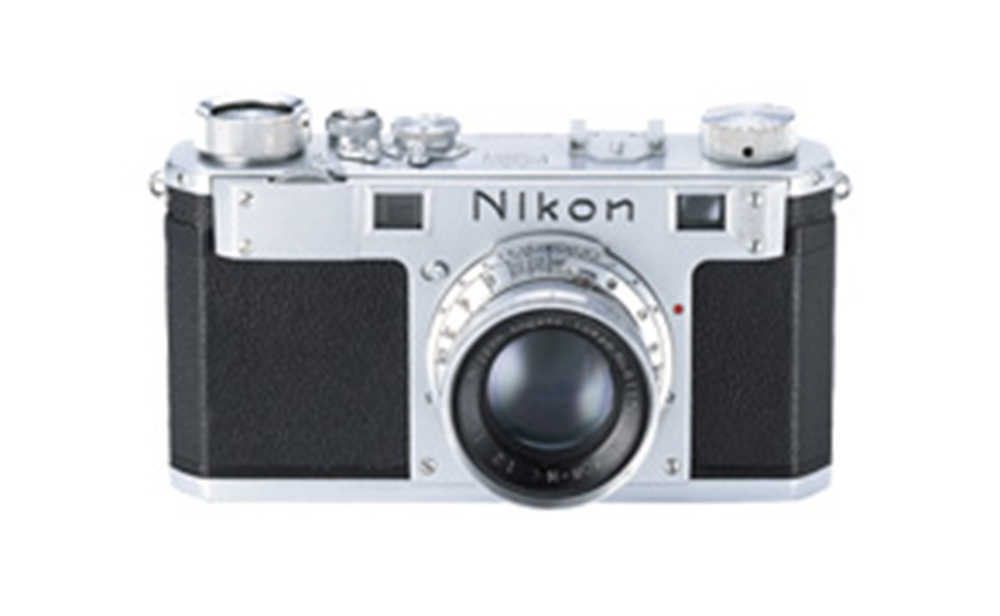
In the process of prototyping, improvements were addressed with regard to the problems of function in each section. For example, light leaks and the guarantee of the stability of slow shutter operation. The drawings were amended each time, but in order to hasten the completion, the mass production of parts were started before the problems were completely settled. The confusion was addressed in the work-shop, and the first two pieces of prototype were only completed in November, 1947.
The specifications of the camera (it was called the Nikon Camera later) were as follows :
| Shutter type | Horizontal-travel focal-plane shutter |
|---|---|
| Shutter curtain | Rubberized cloth-curtain ("Habutae" silk) |
| Shutter speed | T, B, 1 ~ 1/500 sec. |
| Sync contact | None |
| Viewfinder | Reversed Galilean type, magnification 0.6x, frame coverage 85 % |
| Picture size | 24 x 32 mm ("Nikon" format) |
| Winding | Knob |
| Rewinding | Rewinding knob with A-R lever |
| Weight | 765 g (with NIKKOR-H.C 5cm f/2) |
The prototyping was completed in March 1948, and mass production started without interruption.
Subsequent production adjustments to ensure the best finishi for the camera were developed and after 1949 production started to flow smoothly.

In the process of the evelving development of the camera, some original inventions were incorporated into the camera design.
One of them, for example, was the shutter mechanism.
In order to improve the accuracy and durability, while controlling the rotational friction of the focal-plane shutter to a minimum, a radial bearing was used the first time.
While cameras of other makers located the slow shutter dial at the front of the camera, the Nikon Camera made it coaxial, arranging the slow shutter dial and fast shutter dial concentric, therefore, enabling it to operate at the top of the camera.
The Release of the Nikon Camera
Announcement of Nikon I and Improvement to Nikon M and Nikon S
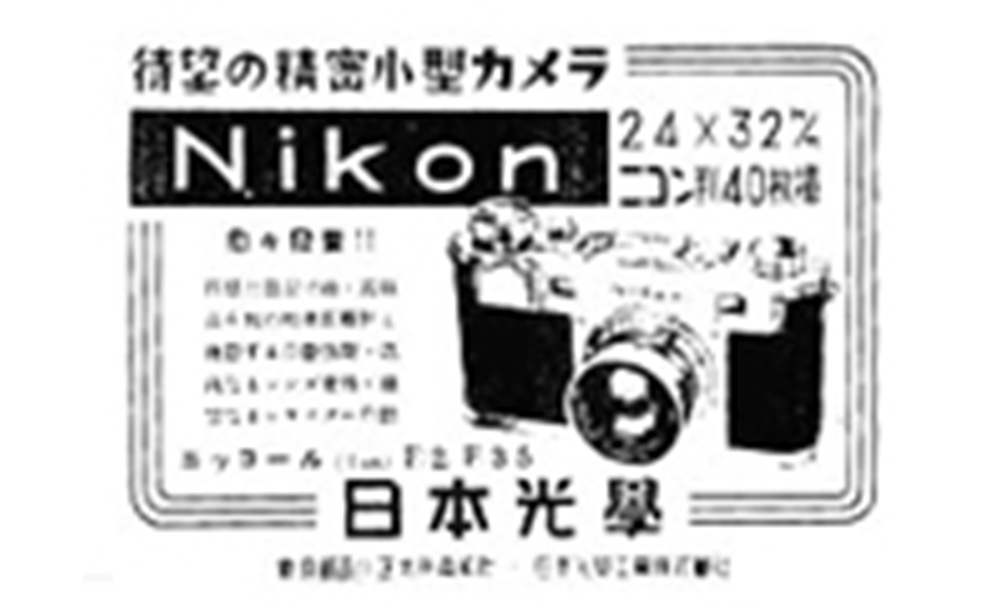
In the "Photographic Community in Japan," there were a lot of expectations for the release of our new camera.
Therefore, in October1947, just before the completion of the first prototype, we announced the Nikon Camera (later it was called the Nikon I, to distinguish it from the later models) and started advertising. The domestic retail price for the camera with the NIKKOR 5cm f/2 was fixed at 57,690- Japanese Yen, and released in March, 1948.
The sales Department immediately started negotiating with Trade Corporation and closed a deal of 200 sets of NIKKOR 5cm f/3.5. Of the 200 sets, 50 sets were exported to Hong Kong in October. This was the first export of the "Nikon" camera.
In the next year, 1949, the production quantity of the Nikon Camera (Nikon I) was increasing gradually, and in March, the second purchase by Trade Corporation was made. 110 sets were exported to the U.S.A., Europe, Hong Kong and Singapore.
The reason why the export proceeded in this way was because the Ministry of Commerce and Industry took the measure of promoting foreign export. They assigned all of the production to export, and did not permit domestic sales. The only exception was for a special-purpose demand in October 1948, in response to the strong request of GHQ (General Headquarters) to allot the production of cameras mainly to export.
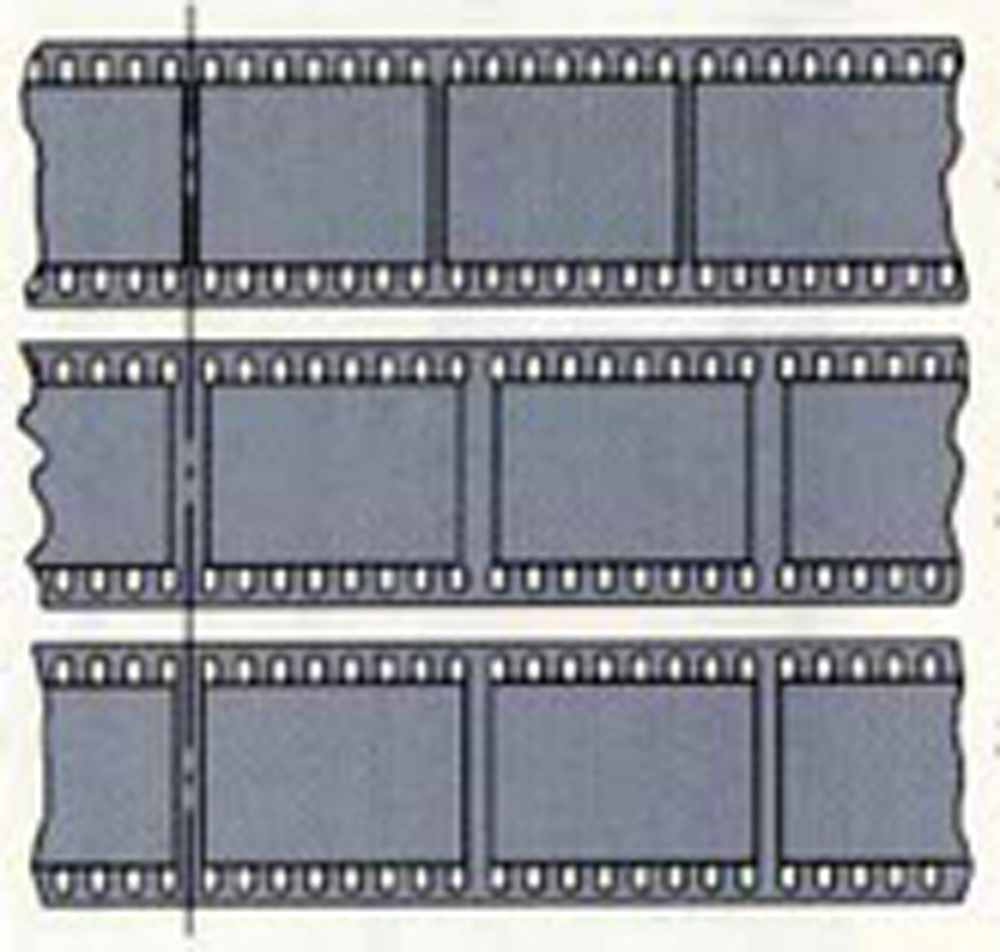
There was one big dilemna with the camera. The picture size of the "Nikon" format (24 x 32 mm) did not correspond to the automatic color slide cutting machines that were used in the U.S.A.
Those machines operated with the Leica format (24 x 36 mm), and if film from the "Nikon" format was used, the pictures would be incorrectly cut.
Because of this problem, GHQ did not permit export of the Nikon I, and CPO hesitated to place the order.
To solve the dilemna, the camera's frame size had to be changed immediately to a 24 x 36 mm size.
Even if castings of the body already worked for the "Nikon," format had to be remodeled. It was impossible to broaden the width to the standard 36 mm.
It was impossible to change the body and to bear the heavy cost of changing the parts. It was a difficult situation for the company, as delay in delivery was not permitted.
Therefore, the maximum modification was made to change the feed of the film to 8 perforations per frame, the same as that of the "Leica" format. The overall construction was not changed, which had a size of 24 x 34 mm.
The prototype of that was completed in July 1949, and it was decided that this model would be put on the market as the Nikon M. Moreover, the Nikon I was discontinued in the same month at the aggregated sum of 738, and all the I inventory was reconfigured to the Nikon M. Beginning in August, the production was switched over to the Nikon M.
The Nikon M was released in October 1949. It was still irregular in picture size but changed to 36 frames, therefore removing the impediment for export.
In January 1949, its monthly production exceeded 100 pieces, and July, it exceeded 200 pieces. These quantities fulfilled domestic demand.
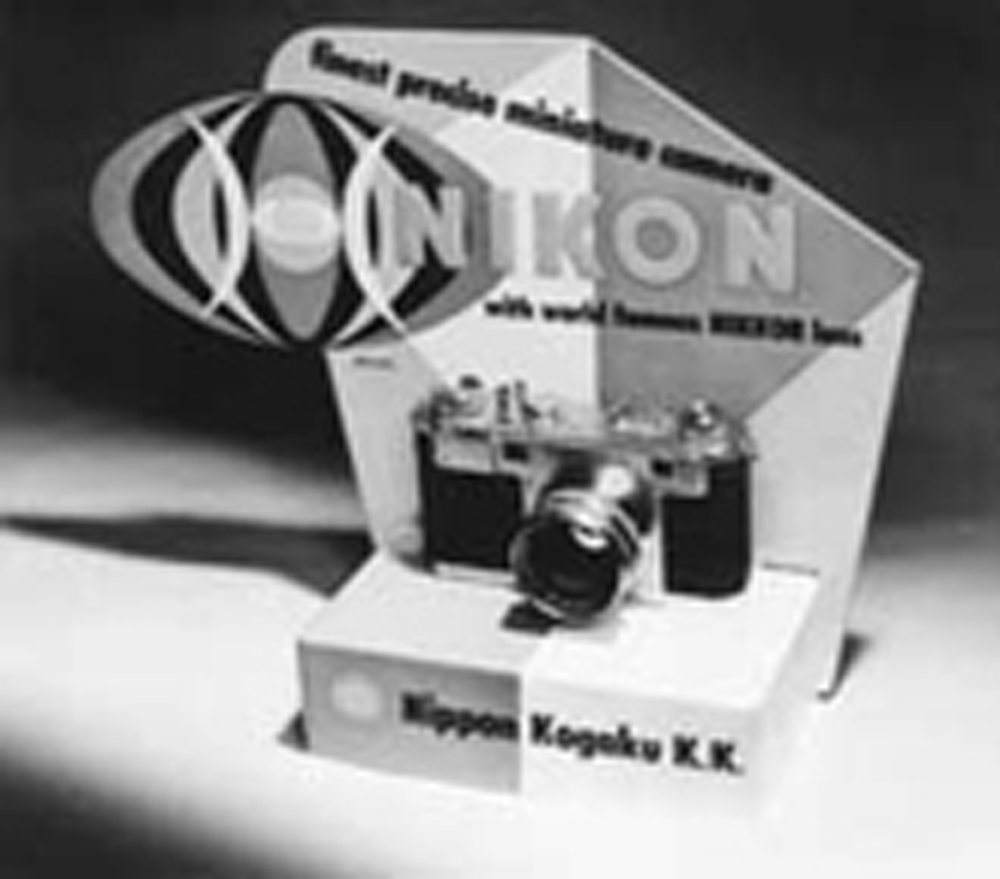
In the spring of 1950, in the U.S.A., one of the export destinations, it was pointed out as a drawback that the Nikon M lacked the flash synchronization mechanism.
Therefore, the Nikon M body was modified to incorporate two synchronization contacts. S (slow) and F (fast), on its left shoulder of the body. Subsequently the production was completely switched over in November.
This camera was called the Nikon S and was released in December.
At the same time, the "Flash gun model BCB" was released.
Incidentally, in March 1950, when Nippon Kogaku was in a difficult business condition, the prototype order was issued to modify the Nikon M to the "Leica" mount (M39 screw mount) . It was management's judgment that the difficult-to-work bayonet mount should be switched to an M39 mount. They anticipated it would have "the effect of production reinforcement and a reduction in production costs," by unifying the two systems of lenses for the Nikon S and M39 mount into one.
In November, the prototype was finished, examined and discussed.
At that time, there was a strong opinion among engineers in charge that the mount, once on the market, should not be changed without more study. Considering that the "Nikon" name became well known in various fields, and the business situation was getting better, the proposal to change the mount was denied. In 1951, the production system was switched to the monthly production system. As a result of the reduction of fabrication time and the improvement of the yield, the monthly production exceeded 500 pieces at the end of 1951, and topped 1,000 pieces in June 1953.
Development of Nikkor Lens for the Nikon S Series
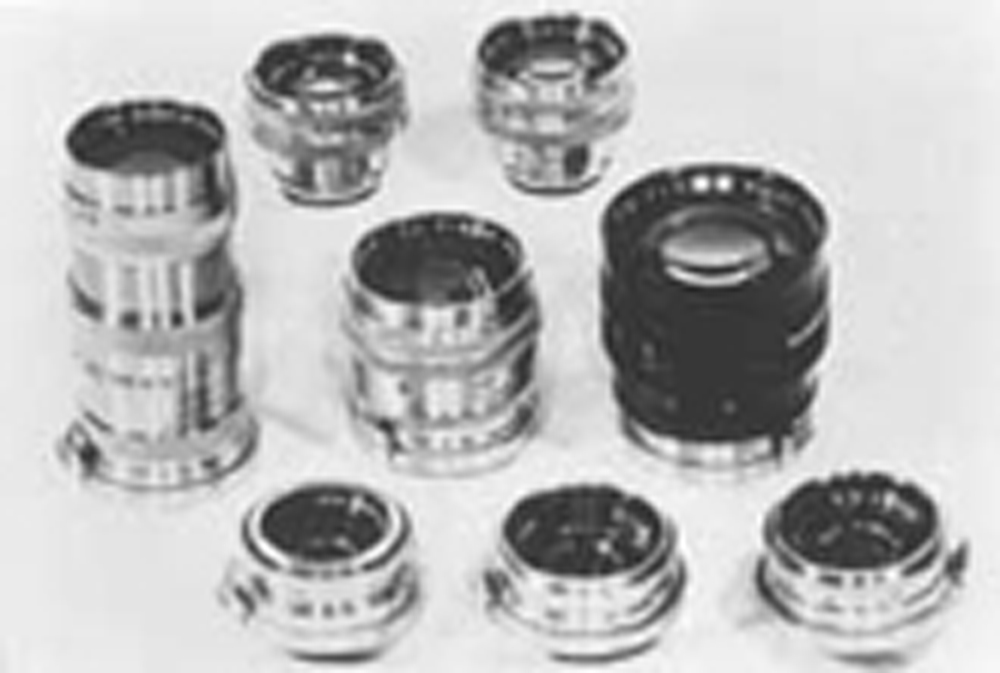
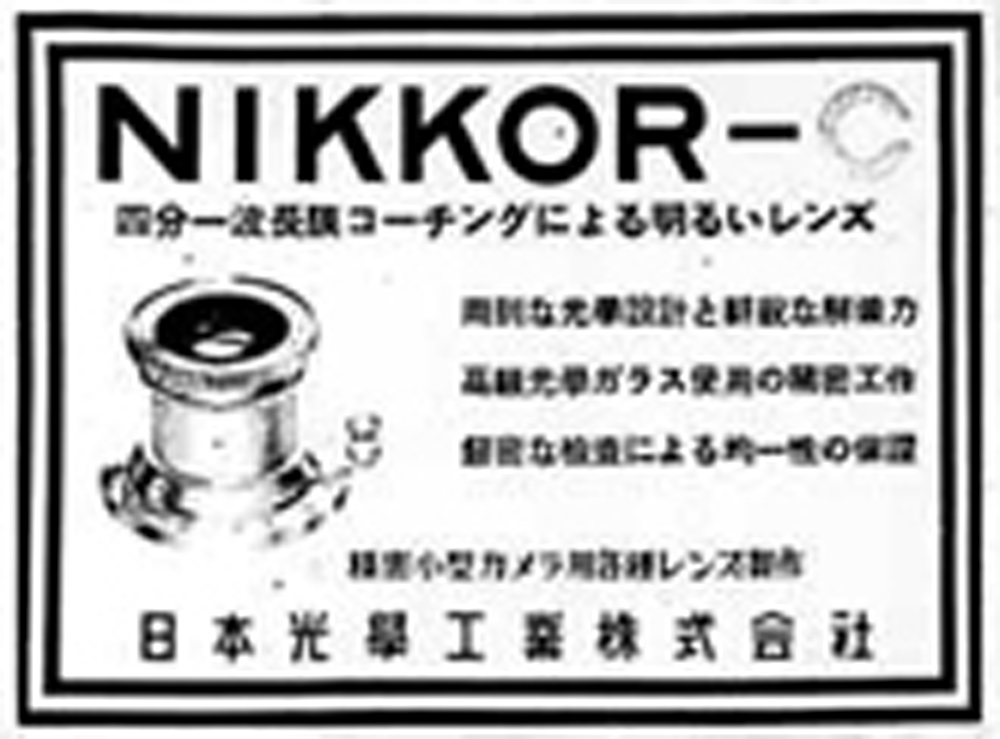
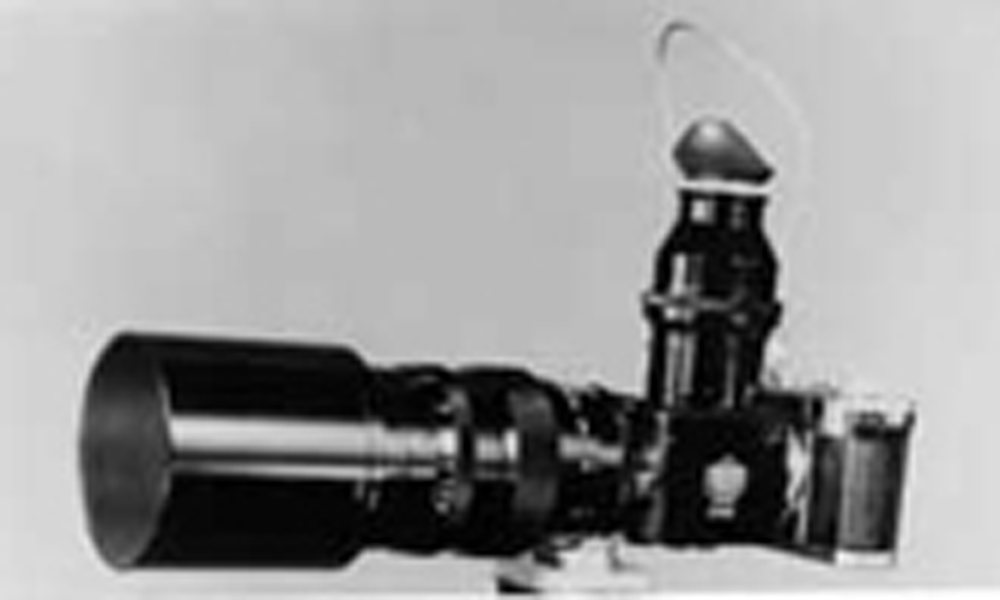
Regarding the photographic lens, in December 1945, the production of a standard lens 50 mm f/3.5 (product name was NIKKOR-Q.C 5cm f/3.5) (Leica screw (M39) mount) for 35mm(135 format) camera was recommended.
In 1946, in addition to the standard lens (focal length 50 mm), the 50 mm f/3.5, f/2 and f/1.5 were planned for manufacture, and in 1947, the production of the 50mm f/2 (product name was NIKKOR-H.C 5 cm f/2) was started. However, the glass stock was exhausted and the company was compelled to redesign the optics using another type of glass.
The plan was to produce the necessary optical glass at Nikon's Ohi Plant (Shinagawa-Ku, Tokyo). Production gradually increased and the required glass soon becamer available.
In particular, with the success of melting barium flint glass (a kind of high refractive index, low dispersion glass) BaF10, the performance of the NIKKOR-H.C 5cm f/2 began to stablilize and in January 1950, the f/1.5 was released.
Additionally, a wide-angle 35mm f/3.5 (W-NIKKOR 3.5cm f/3.5), a telephoto 85 mm f/2 (NIKKOR-P.C 8.5cm f/2), and a 135mm f/4 (NIKKOR-Q.C 13.5cm f/4) were manufactured and released as interchangeable lenses for the Nikon S mount and Leica screw mount by 1949.
The 50mm f/1.4 (NIKKOR-S.C 5cm f/1.4) was released in July 1950, and the 135mm f/3.5 (NIKKOR-Q.C 13.5cm f/3.5) was released in December. The production of these lenses marked the beginning for making fast aperture lenses.
In order to evaluate the performance of a prototype lens, pictures actually taken had to be compared with pictures taken by other lenses. It was auspicious that we had many photographic lenses of a foreign make, so we could fo a thorough investigation.
In April 1946, a soft optical coating was applied to the NIKKOR 5cm f/3.5; i.e., to the surfaces of the lenses inside the lens barrel, in order to increase light transmission. This type of coating had a good history of prior use with photographic lenses.
In the beginning, a soft coating of cryolite was used, then as of January 1948 magnesium fluoride was used and further improvement was added as of September 1950; i.e., the anti-reflection coating was changed to a hard coating .
Due to the application of coating, the loss of light volume caused by the reflection at the lens surface was reduced, and the correction of aberrations was made possible by increasing the number of lens elements.
The coating displayed its power for preventing internal reflection (flare), and was quite helpful for the design of large-aperture lenses and wide-angle lenses.
From 1952 to 1954, the large-aperture telephoto 85mm f/1.5 (product name was NIKKOR-P.C 8.5cm f/1.5), the 105mm f/2.5 (the NIKKOR-P.C 10.5cm f/2.5), the wide-angle 35mm f/2.5 (W-NIKKOR 3.5cm f/2.5) and the 28mm f/3.5 (W-NIKKOR 2.8cm f/3.5) were released in succession. The telephoto 250mm f/4 (NIKKOR-Q.C 25cm f/4) which used the reflex housing was also released.
Strict Eye for Inspection
Basic Idea of Inspection: "Ensuring Quality by Inspection"
It had been our tradition since the founding of the company to manufacture the highest quality products with scrupulous care. However, soon after the conversion to consumer goods, some of the products were found to be unsatisfactory because the management and maintenance of machines were not satisfactory and good material for products could not be obtained.
Regarding inspections, the Inspection Section was organized in the Production Engineering Department, but as the main product was binoculars, the operation was too small-scale as to be accommodate necessary dedicated personne.
In our company, since prewar time, inspections were conducted for war equipment and supplies. Basic policy dictated that priority be given to judging and selecting products based on passing strict military inspections, without regard to the cost. The standard and method of inspection for products which would be accepted by the military authority were written in documents. The necessary inspection equipment was made, with important emphasis placed on whether the product could endure the severe condition of the environment in which they would be used (temperature, humidity, vibration, etc.).
Moreover, inspection sections had such various unique precision machines and inspection instruments found exclusively within Nippon Kogaku, and sometimes they were used by production engineering to solve technical problems in the inspection process.
This very high inspection process extended into Nippon Kogaku's production for consumers' goods.
In February 1947, the organization of inspections was reinforced and at the same time, a quality standard was established. It became company policy not to ship a product if it did not clear this standard.
The basic idea of inspection was "to define the quality of a product in accordance with the inspection section guidelines." Both photographic lenses and microscopes were rejected without mercy if they did not reach the standard of quality required.
In particular, as the sensory evaluation was becoming increasingly important for the inspection of consumers' goods, it was a heavy burden for the production departments as they had little experience. However, with the benefit of feedback from the market place, the inspection departments judged with strict eyes.
Knowing that the products were being well received by consumers as high-class products, made in Japan, gave the company high confidence. Eventually, Nippon Kogaku's domestically made products became the choice for Japanese consumers, over those of other companys' imported goods, and Nippon Kogaku's products were also well accepted in export markets as high-quality products.
Our company also paid attention to quality control (QC) early on Engineers in the production and inspection departments attended the lecture of Dr. W. Edwards DEMING who came to Japan in 1950. Subsequently, they also participated in the quality control seminar (basic course and advanced course) of the Union of Japanese Scientists and Engineers.
Furthermore, our people studied the QC of Dr. Joseph M. JURAN who preached the quality control from the standpoint of business administration, and in 1954, our management participated in the Quality Control Top Management Seminar.
Our studies at these seminars clarified our understanding that QC rejection at the inspection stage, sorting out defective products, was not the correct approach. Rather, we would establish production and inspection techniques that would prevent defects! Furthermore, we studied ways to stabilize all processes through improved administration, objective method inspection and other techniques.
In the meantime, during February 1951, we received an order for the repair of optical instruments which included cameras for reconnaissance airplanes and, surveying by the U. S. Airforce in the Far East at Tachikawa base.
Through this work, quality control in practice could be studied, since the repair had to be conducted in conformity with the U. S. MIL-SPEC of QC.
As a result, the principal of sampling inspection was introduced to inspection for mass production.
In August 1954, the inspection section of the Production Engineering Department was organized as an independent Inspection Department in order to accommodate the increase of production output.
Improvement of Inspection Method

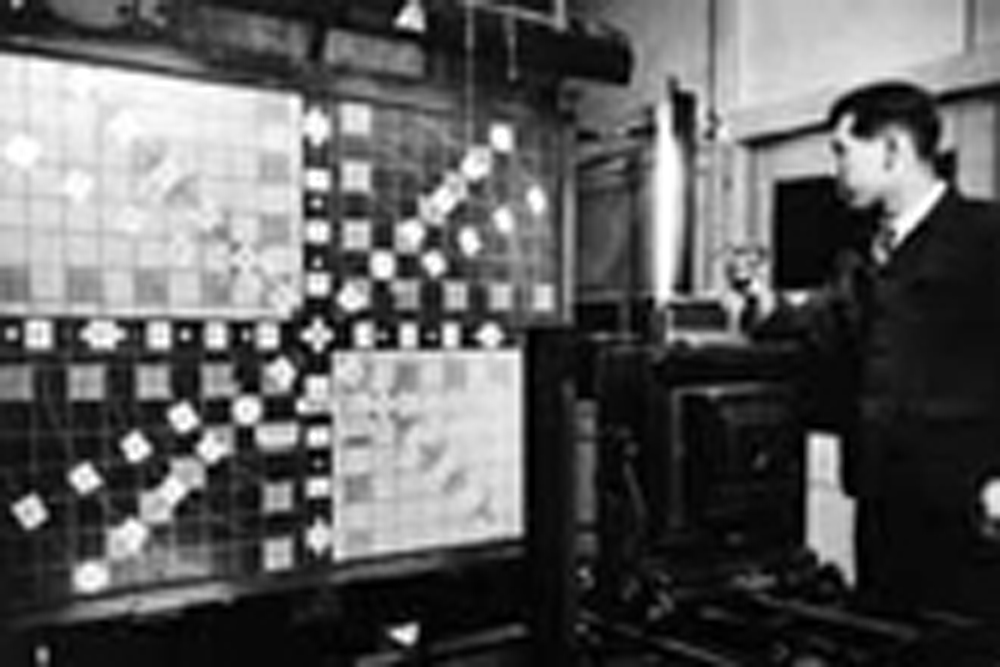
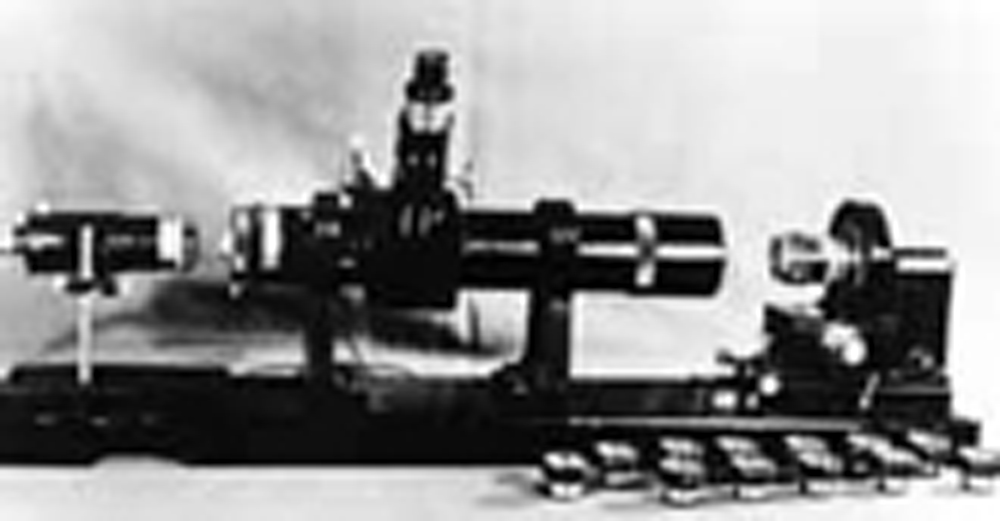

To achieve the objective of producing high-quality products,an inspection method was expedited.
Regarding inspecting the performance of photographic lenses, we made inspections of the optical axis with only a simple piece of equipment, called optical axis inspection equipment. The "Hartman optical bench" which was used during war time was not operational.
Using the optical axis inspection, only spherical aberrations could be found to some extent, but aberrations including astigmatism, coma and distortion could not be measured.
In 1947, the "projection inspection method" was originated as the method for inspecting these aberrations.
According to this method, the photographic lens to be inspected was attached to the slide projector in place of the projection lens. The resolving power of the lens was judged by projecting the image of a "test chart" on the ground glass through the lens being tested. This technique produced good results. In 1947, when the production of the NIKKOR-H.C 5cm f/2 lens was started, picture-taking inspection was added for all lens type to be tested, in addition to the projection inspection.
In the inspection room, "Three-dimensional chart" for picture-taking inspection and "Infinity-collection chart" with a collimator were installed.
In August 1948, when the output of the 5 cm f/2 lens increased, the "Hartman optical bench" was repaired and could be used.
The comparison of the measured value and the design value was made very easily and the correction of the design was done efficiently.
At approximately the same time, the projection inspection instrument was also improved so that remote control focusing could be made from the position of the observer.
The "Hartman optical bench" which took one or two days for measuring spherical aberrations and astigmatism were replaced with the imported "Vaisala equipment," which finished the measurement in about an hour.
Beside this, the "focal plane inspection equipment," which brings the position of focus of each lens to the precisely same position was developed, and the inspection items for photographic lenses were well regulated.
The inspection method for the camera was also a difficult problem.
In the beginning, as we did not have inspection instruments, various defects were found at the stage of prototyping, but we made inspection instruments and achieved our original standard.
Our cameras were designed and manufactured with very strict standard values (for the shutter time, aperture stop, etc.) of two third (2/3) of the limit set by JES, in accordance with our original standard. Upon making the inspection instruments, the greatest difficulty was encountered in relation to the shutter test.
We carefully worked to develop the method of measurement, accuracy and durability of the shutter, and resistance to heat and cold, etc. It the beginning, we used an "afterglow type shutter tester" for shutter time inspection of finished products.
This tester was developed for inspecting Nikon, and was sold as a product which was well accepted.
It was the trend to have the higher top shutter speed. The development of a measuring machine of minimal reading error was urgently anticipated.
Therefore, in 1952, a "shutter tester directly reading 1/1,000 sec." was developed. In 1953, a more stable "numerical shutter tester" was developed, and from 1954, the tester was switched to this numerical type tester.
Nikon and Nikkor in the Spotlight
Encounter with "LIFE" Photographers
One day in June 1950, David Douglas DUNCAN, a staff photographer for "LIFE," Horace BRISTOL of "FORTUNE," and MIKI, Jun who was actively working at "LIFE" as the only Japanese contract photographer there, visited our Ohi Plant.
In reference to their visit, MIKI wrote an article entitled "Nikkor and I" in the "Nikkor Club Quarterly magazine No. 26" (issued on November 30, 1963), as follows :
......One day, Mr. MURAI, Ryuichi, a professional photographer came to LIFE to see his friend.
As he had an unfamiliar lens, I asked him to show it. It was the Nikkor 85mmf/2 lens. I borrowed it and took snap shots of Mr. Duncan, saying, "This is Japanese Sonnar."
"Oh, Japanese Sonnar. Where's a Japanese Cadillac ?" laughed he with a tone of kidding the imitation paradise Japan.
I made an enlarged print of 8 x 10 in. (approx. 20 x 25 cm) from the negative just taken, and I showed it to him, saying, "The picture is taken well even with a Japanese Sonnar."
Upon looking the picture, his countenance changed at once. With taking out a magnifier, "Amazing! It's very sharp ! Whose product is it ? Let's go to this company right away. Contact them, please." said he in rapid succession......
President NAGAOKA, Masao guided DUNCAN and BRISTOL who visited the Ohi Plant to tour the factory by themselves. He explained "all lenses were very strictly inspected one by one, and each lens had about the same degree of accuracy." In the inspection room, they compared their Leitz and Zeiss lenses to that of Nikkor, with the projection inspection equipment.
They praised, "The Nikkor is better than German lenses," and bought Nikkor lenses for Leica.
When the Korean War broke out on the 25th of June, DUNCAN who was staying in Japan went to the front line with two "Leica IIIc's" equipped with a NIKKOR-S.C 5cm f/1.5 and a NIKKOR-Q.C 13.5cm f/4 respectively.
A few days later, Carl MYDANS, who was famous as a photographer for "LIFE" since its inauguration, was dispatched particularly to cover the Korean War.
MYDANS, pushed by DUNCAN"s rather forceful recommendation, visited our company, and also bought Nikkor lenses for his favorite "Contax".
For this purpose, our company modified the range finder coupling section of the "NIKKOR-P.C 8.5cm f/2" and the "NIKKOR-Q.C 13.5cm f/3.5" prototype lens for "Contax" in July.
Later, he also changed his camera to Nikon.
DUNCAN and MYDANS took almost all of their pictures of the Korean War with their Nikkor lenses. Numerous valuable pictures were carried in the pages of "LIFE." and they won the "U.S. Camera Awards" of 1950 for those works.
Hank WALKER who came to Japan in place of DUNCAN, went to Korea with his camera changed to a Nikon M, as well as Nikkor lenses.
In December, the Korean Peninsula changed to a place of severe cold, and the temperature sometimes went down to -20 C.
While other cameras were frozen and didn't work, Nikon worked in good order and recorded how severe battle was fought.
Consequently, based on the experiences of the "LIFE" photographers who covered the Korean War, a Nikon with a black painted finish, designed to minimize light reflects that could be observed by others, was made. This was the first black colored Nikon body.
Evaluation by "New York Times"
Nikon and Nikkor used by DUNCUN and MYDANS in the Korean War evoked a big response in the U.S.A.
The "New York Times" issue on December 10, 1950 carried the following article by Jacob DESCHIN titled "JAPANESE CAMERA" which said that Nikon and Nikkor were scrutinized by experts and approved for their excellence.
The first post-war Japanese camera to attract serious attention in America has created a sensation among magazines and press photographers following the report by Life photographers in Korea that a Japanese 35mm camera and its lenses had proved superior to the German cameras they had been using.
The camera is the Nikon, in general appearance a facsimile of the Contax but combining important features of both the Contax and the Leica plus some innovations.
The lenses, which include a full range of focal lengths are Nikkor, to which American experts give a higher accuracy rating than the lenses available for the German manufactures.On the strength of the enthusiasm expressed by its photographers in Korea, Life arranged for a thorough examination of the cameras and lenses by experts here, and after the equipment had been approved by them, proceeded to canvass the magazines staff with the result that a considerable quantity will be ordered.
Look magazine photographers also are buying some of the Japanese equipment.
In this article, the same paper reported the results of lens examination as follows :
Mitch Bogdanovitch of Eastern Optical Company, the lens expert, put the Nikkors through a series of rigid test and found that the average quality was much higher than that of the German lenses.
"The lenses are highly accurate and efficient," he reports "and by comparison with German lenses more uniform in quality."
He praised especially the 50mm f/1.4 and the 135mm f/3.5 for their resolving power and minimum aberrational faults.
Frank Scherschel, chief of Life's photographic laboratories, said 50mm f/1.4 was sharper than Sonnar f/1.5.""Martin Forscher, the export who examined the camera carefully as to mechanism, quality of workmanship and appearance, described the Nikon as "a combination of what I feel are the better components of the Leica and the Contax.".......
"In the past," he said, "Japanese cameras have looked nice on the outside but on examining interior it was found they were crudely made and inefficient, reflecting a low standard of craftsmanship.
The Nikons, however, are made to close tolerances of accuracy and are well finished."......
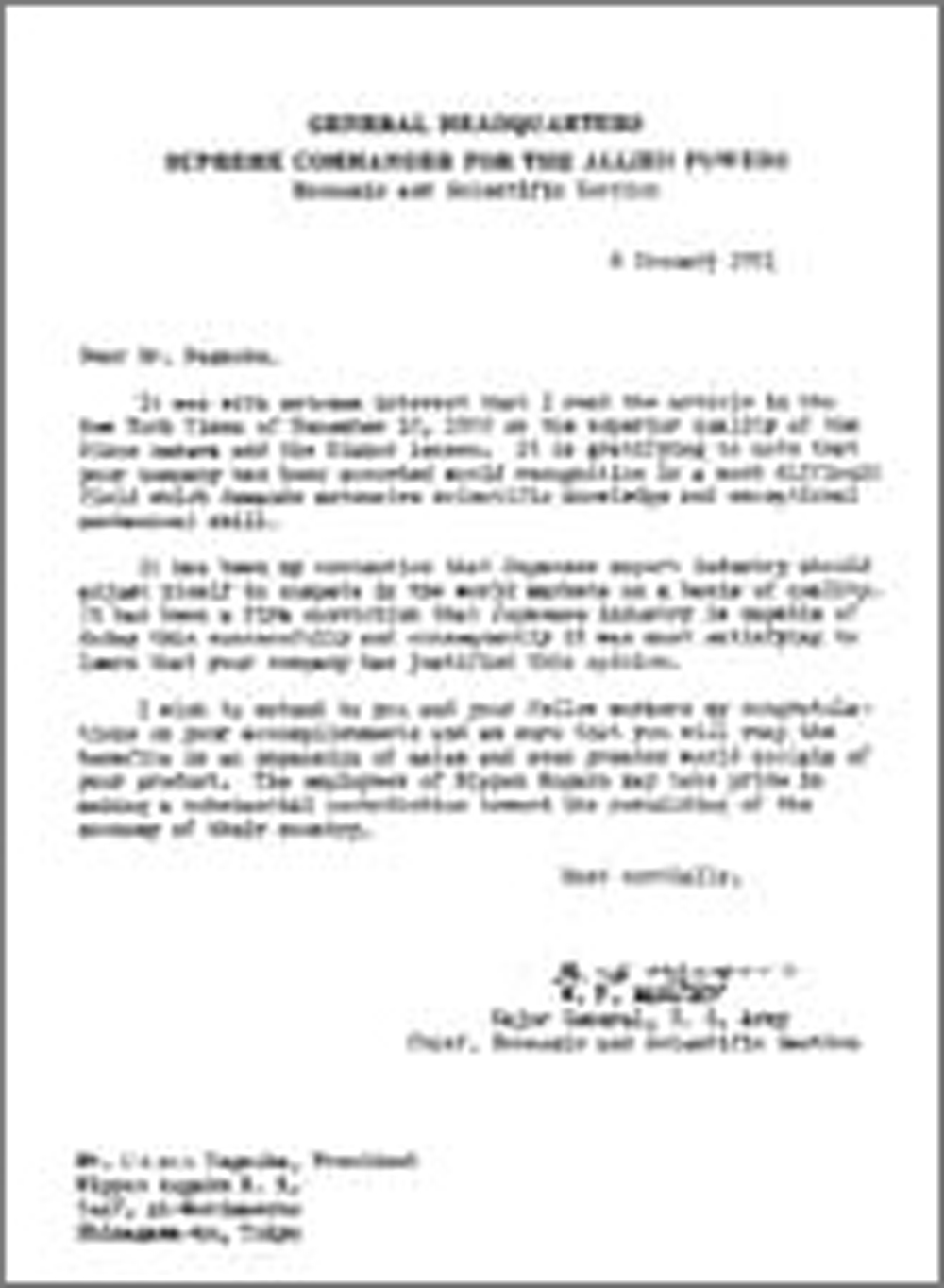
Major General, U.S. Army
The effort to pursue and accumulate the technology over long years while following our tradition of quality-first bore fruits and our technology received a favorable reputation internationally.
On January 6, 1951, Major General W. F. MARQUAT, the Chief of Economic and Scientific Section of GHQ sent a letter to President NAGAOKA, Masao and encouraged our company.
"......It is gratifying to note that your company has been accorded world recognition in a most difficult field which demands extensive scientific knowledge and exceptional mechanical skill.
......The employees of Nippon Kogaku may take pride in making a substantial contribution toward the rebuilding of the economy of their country."
Our Nikon and Nikkor attracted the attention of the photographic community both inside and outside of Japan. In addition to the "LIFE," order many other magazines and press photographers took the opportunity to adopt Nikon and Nikkor. From that time on, newspapers and magazines carried the article showing the outstanding performance of the equipment.
As special procurement boom contributed to both export and domestic sales of the Nikon S which grew rapidly. Both the spot of production and sales presented an active appearance.
Swipe horizontally to view full table.
| Year | Domestic | Export | Total |
|---|---|---|---|
| 1950-04 to 1951-03 | 337 | 2,196 | 2,533 |
| 1951-04 to 1952-03 | 1,152 | 4,310 | 5,462 |
| 1952-04 to 1953-03 | 2,445 | 5,829 | 8,274 |
| 1953-04 to 1954-03 | 4,678 | 8,195 | 12,873 |
Development of Nikon S2
Announcement of Nikon S2 and Public Reaction
The normal lens NIKKOR-S.C 5cm f/1.4 completed in July, 1950, was favorably accepted, as it was the "brightest lens," and its aperture stop had the click-stop.
On the other hand, the Nikon S had room for improvement regarding the brightness of the rangefinder and finder magnification of 0.6 x.
Around February 1951, as the improvement of the rangefinder optical system (which had been initiated long beforehand) was completed, there was a growing sentiment to remodel, incorporating this new finder.
Redesign was repeated and the prototype was completed in June 1953. The body was made of light-alloy diecast, and the picture size was the standard size of 35 mm film, 24 x 36 mm ("Leica" format).
It was decided that the name of the new model would be the Nikon S2. The fabrication of parts started all at once in October.
Thus, the production started smoothly.

Subsequently, in April 1954, at the 4th "Photokina" held in Cologne, West Germany (B.D.R.), Ernst Leitz exhibited the Leica M3 and created a sensation.
In this camera, many new mechanisms were adopted. What attracted public attention was the adoption of the rangefinder mechanism, which switched over the frame in linkage with the lens interchange (variable finder). Our technical staff stimulated by that, completed the Nikon S2 with some modification to the original specifications.
| Shutter type | Horizontal-travel focal-plane shutter |
|---|---|
| Shutter curtain | Rubberized cloth curtain ("Habutae" silk) |
| Shutter speed | T, B, 1 ~ 1/1,000 sec. |
| Sync contact | JIS B type, single synch socket type, FP~X |
| Viewfinder | Albada 1.0 x finder, frame coverage 90 % |
| Picture size | 24 x 36 mm |
| Film winding | Lever (fractional winding possible) |
| Rewinding | Rewinding knob with crank with A-R ring |
| Weight (approx.) | 700 g (with NIKKOR S.C 5cm f/1.4) |
The announcement of the Nikon S2 was made in Tokyo and New York simultaneously in December 1954.
In the domestic market it was released at the same time as the announcement. It sold well from the beginning.
Such various new mechanisms of the Nikon S2 were appreciated by professional and advanced amateur photographers. It offered a one-motion winding lever, convenient for rapid shooting (fractional winding possible), and a rewinding crank lever. It also offered a life-size finder which could be seen with two eyes, as the magnification was the same as the naked eye, with halving (or doubling) progression coaxial shutter.
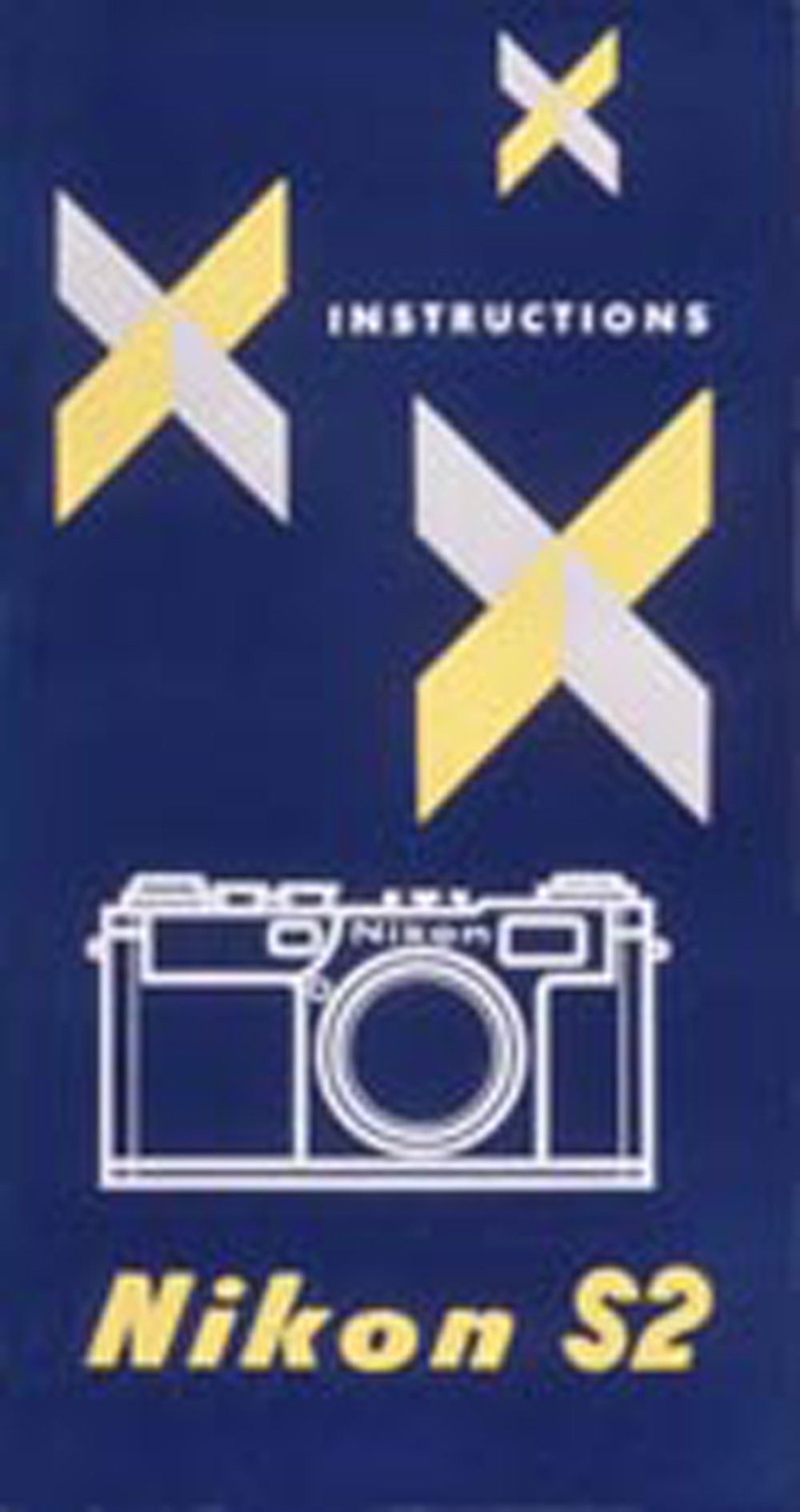
Even U.S. photographic magazines, which had not been eager to introduce Japanese cameras in the past, showed great interest in the Nikon S2.
Leading magazines. including the big three, "Popular Photography," "U.S. Camera" and "Modern Photography," carried articles introducing the Nikon S2, all at the same time.
In February 1955, the Nikon S2 was formally announced to general consumers in the U.S. Market and was met with favorable reaction. Willoughby, the biggest camera shop in the U.S.A., started to sell Nikon for the first time. Additionally, Pearless, a camera shop in New York inserted a full-page newspaper advertisement introducing Nikon.
Although the Nikon had not attracted much attention at the "New York Photo Show" (one of the big three photo shows), held in January 1954, it made a complete change and attracted the attention of the attendants in the "Japan Photo Show" in San Francisco (in May), and in the "Japan Camera Show" (in December) the following year, owing to the appearance of the Nikon S2.
Furthermore, an American consumers magazine "Consumers Research Bulletin" recommended the Nikon S2 in its article entitled "High-priced 35mm cameras" in its June 1955 issue saying:
as far as the 35mm camera is concerned, the Nikon S2 is the world's finest camera in consideration of the price.
As a result, the name of Nikon and Nikkor spread across over the United States.
The Extension of the Region of Photography and the Motor Drive
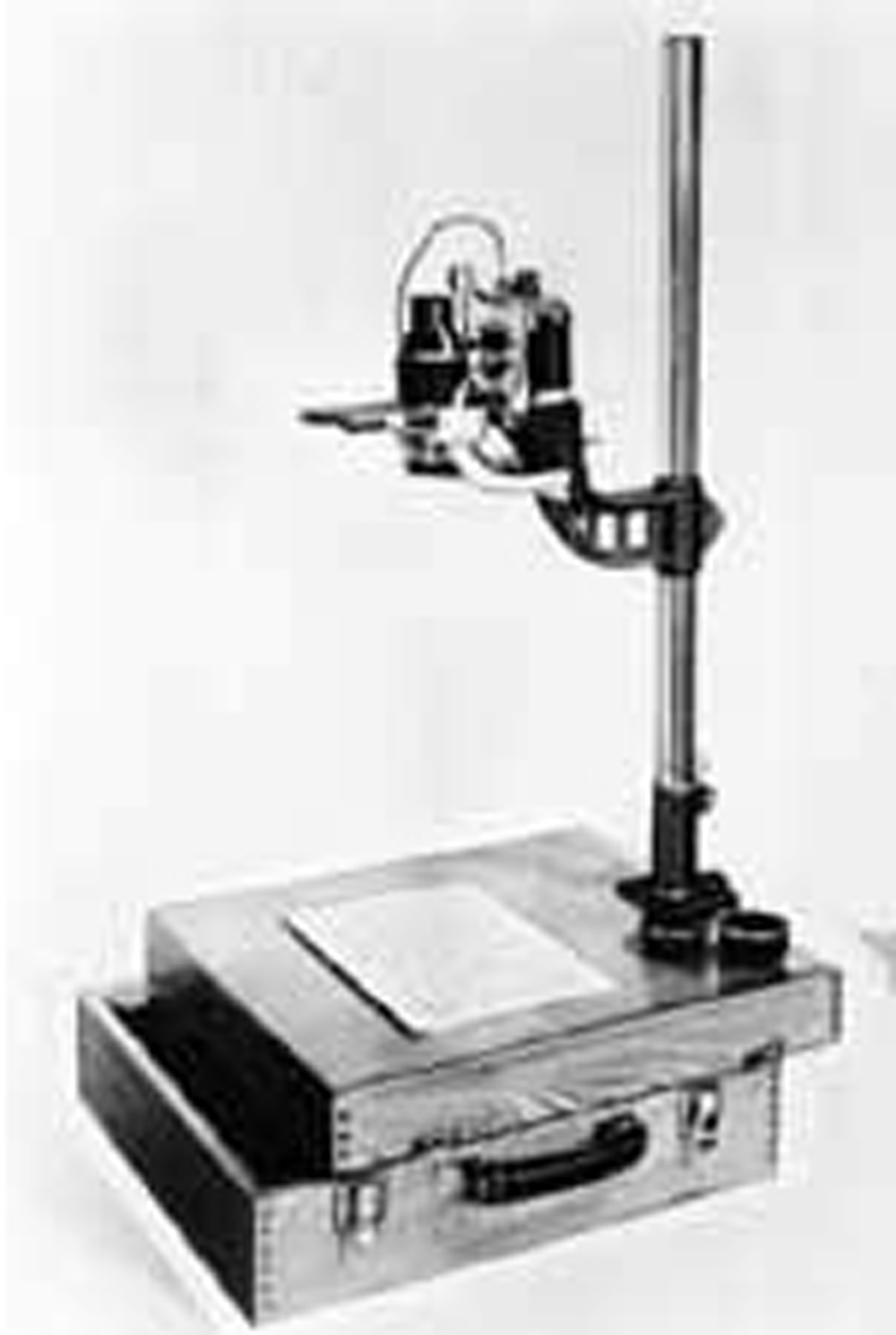
Due to many improvements on the body mechanism, the Nikon S2 became an easy-to-operate camera.
The lens series and accessories for various purposes were expanded. The Nikon S2 use was greatly expanded.
As for the lenses, a large aperture normal lens NIKKOR-N 5cm f/1.1, the wide-angle, W-NIKKOR 2.5cm f/4 with a wider angle of view, and the W-NIKKOR 3.5cm f/1.8, the brightest among wide-angle lenses, were released. With regard to telephoto, the NIKKOR-H 18cm f/2.5 and the NIKKOR-T 50cm f/5 using reflex box, were released.
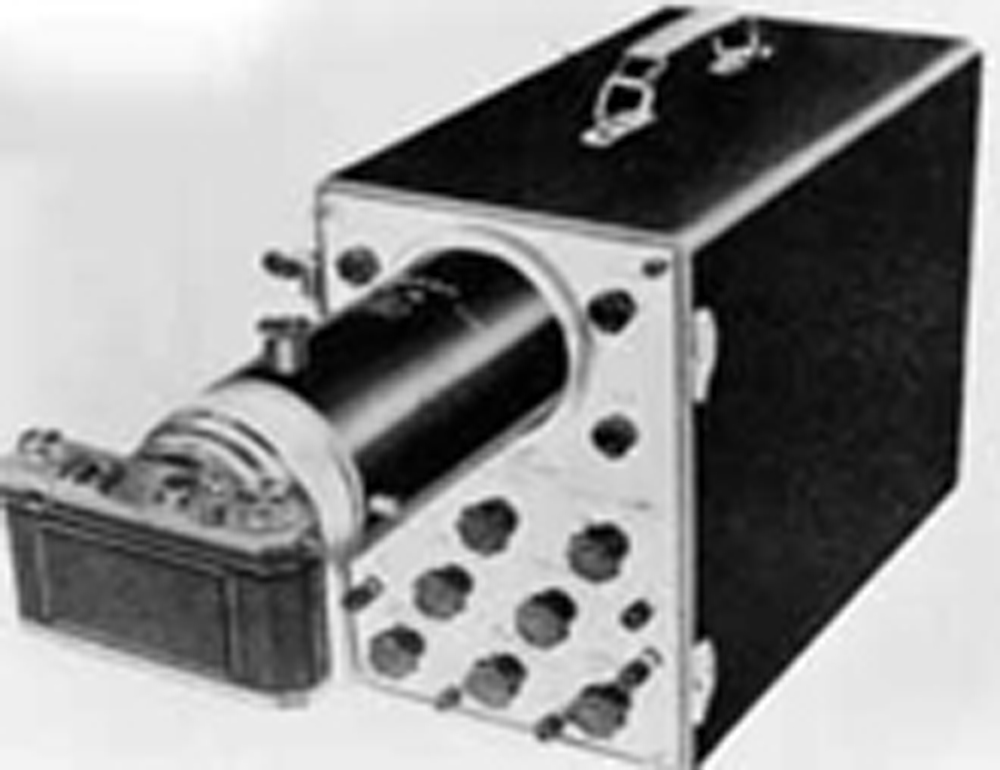
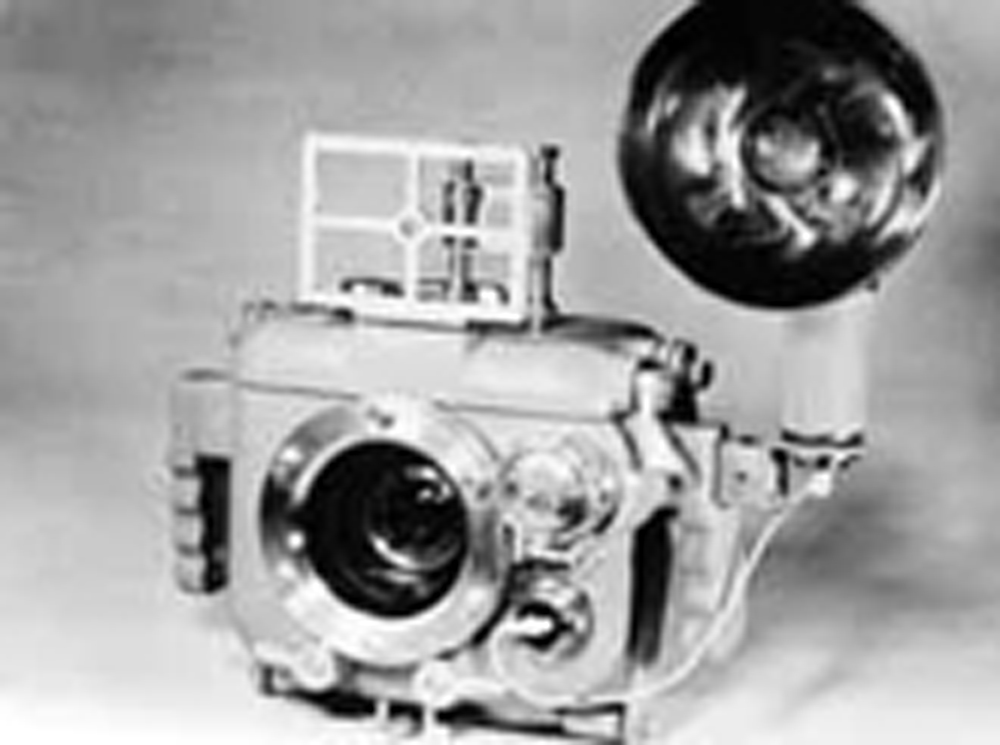
(former model of Nikon Marine)
Regarding accessories, in addition to Close-up Equipment, Copy Outfit, and the Oscilloscope Unit for photographing CRT oscillograph, improved versions of underwater housing Nikon Marine, microscope attachment Nikon MICROFLEX and stereo photo equipment Stereo-Nikkor kit were released. They extended the region of photography and expanded the use in the field of science and research.
Further, in 1957, the Motor Drive for the Nikon S2 which made film winding and shutter charging automatic and had a wide range of use for news and science photography was added (it was a drive unit incorporating a micro motor and was called the Motor Winder at that time).
The news photographers needed rapid shooting, and around 1953, in the course of designing the Nikon S2, a grip type rapid winder which wound the film quickly was made in prototype form. However, it was not put into production as the Nikon S2 adopted the lever on the body top for film winding.
In 1955, our company had the idea of utilizing a micro motor which was developed by a specialist maker of micro motors, who hit upon the idea of using it for automatic winding.
This development was made by the Prototype Section of the Designing Department in the beginning. It was decided that it should be developed as a motor drive using the coupling mechanism (in this case, the section to convey the winding power to winding shaft of the camera body) developed in the course of the prototype of the rapid winder. In October 1956, the prototyping started.
The prototype was completed after several improvements were made to the micro motor, and the shooting tests were repeated. In March 1957, at the "IPEX" (International Photo Equipment Exposition) held in Washington, D.C., an accessory Motor Drive that could perform a continuous shooting at the rate of 2 frames per second (7.5V DC) or 3 frames per second (9V DC) attracted the attention of the attendants.
As the power source, the use of the R6 (American "AA") size dry batteries (six pieces) was planned. However, the field test by U.S. professional photographers proved that it was not good for practical use as the battery consumption was too quick. Therefore it was changed to the R14 (American "C") size batteries.
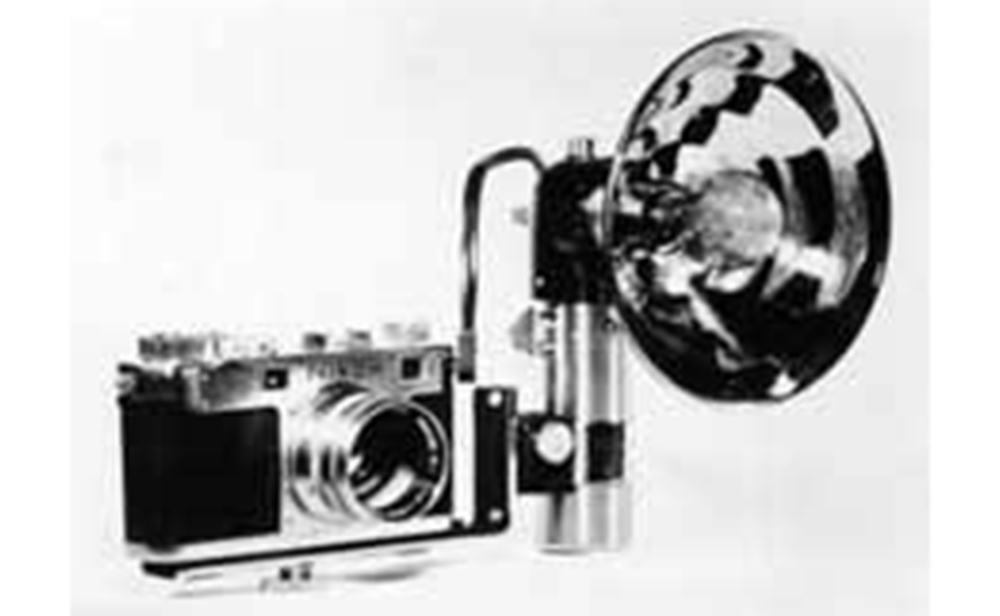
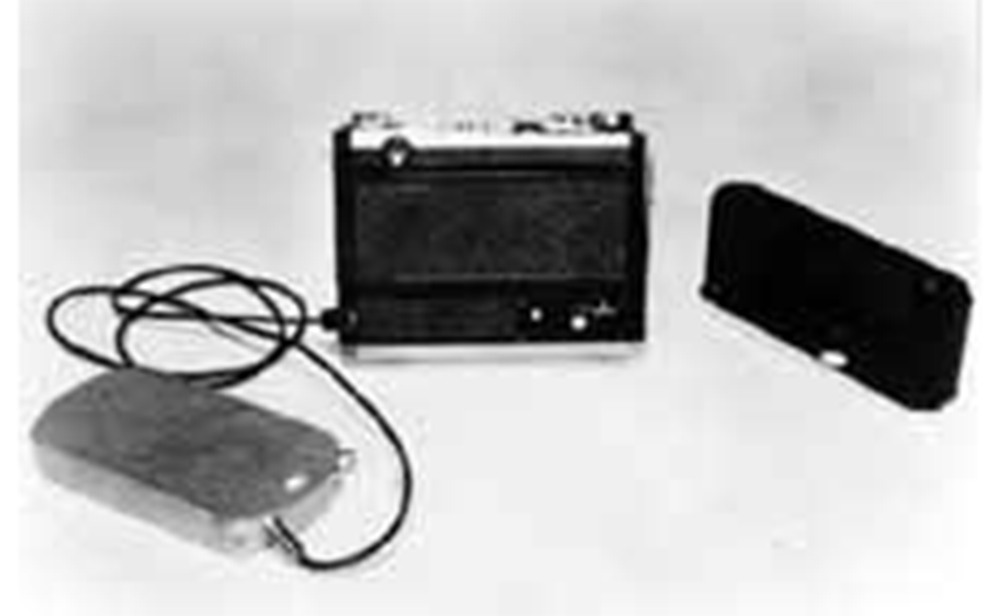
Release of the Highest-Class Camera Nikon SP
Development of Nikon SP
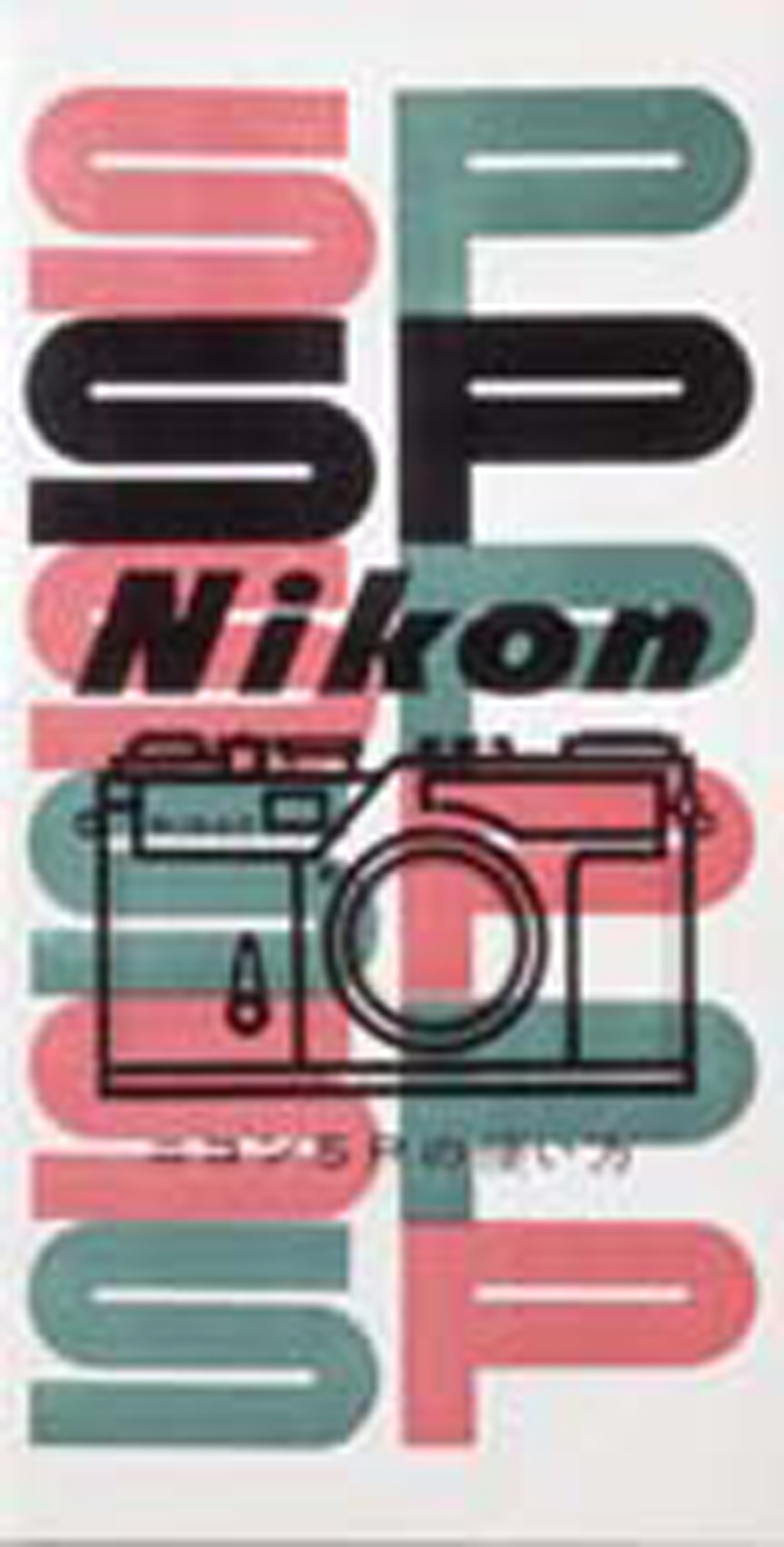
Our company had already started the improvement of handling characteristics of the finder when Nikon S2 was completed.
As the finder of each camera from the Nikon I to the Nikon S2 was exclusively for the normal lens, very time the lens was changed, a separate finder had to be fixed on the accessory shoe of the camera top. Also, each time the distance to the subject was changed, the finder's parallax correction had to be calibrated. Handling was complicated.
It became an objective to develop a finder that exceeded the performance of a variable finder used on the Leica M3. This was important, since the finder determined the framing of a photograph, and gave the first impression about the performance of the camera.
This new rangefinder camera was positioned as the flagship model of the S series, and the planning of specifications for the new product had been started.
In September 1954, the design specifications were fixed and, and the section prototype was started in the beginning of the following year, 1955. Up to 10 kinds of prototypes were made for the finder.
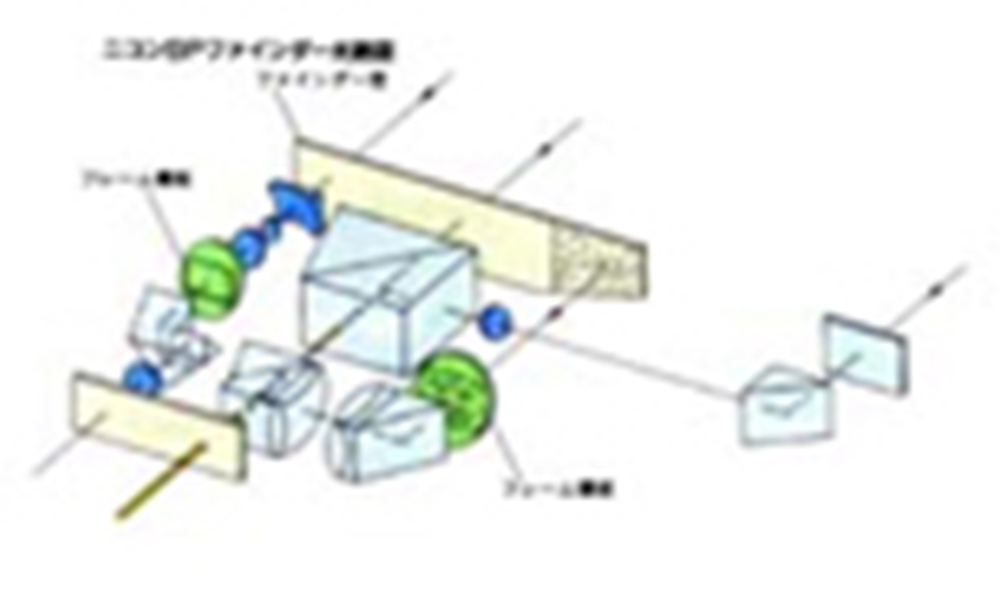
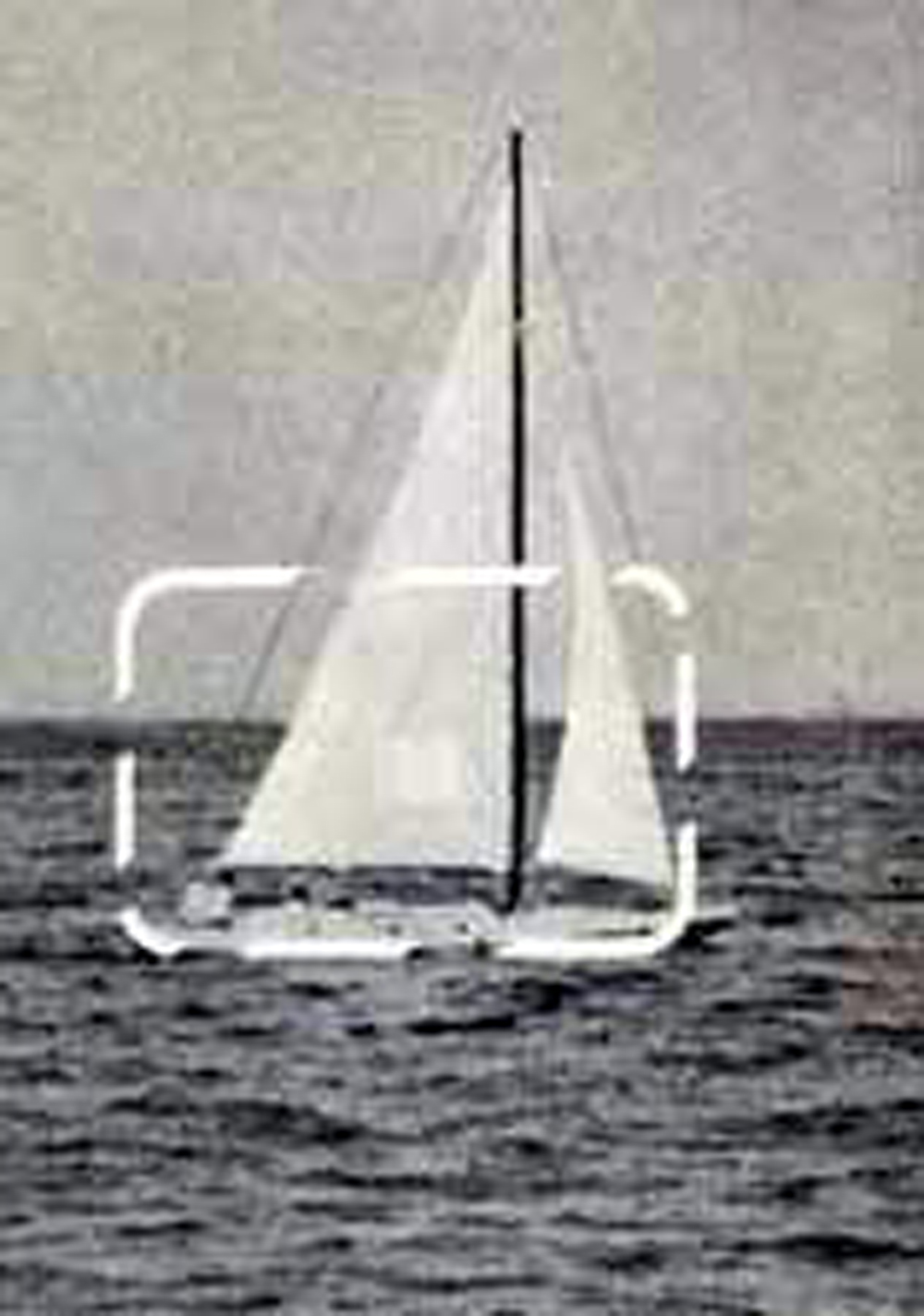
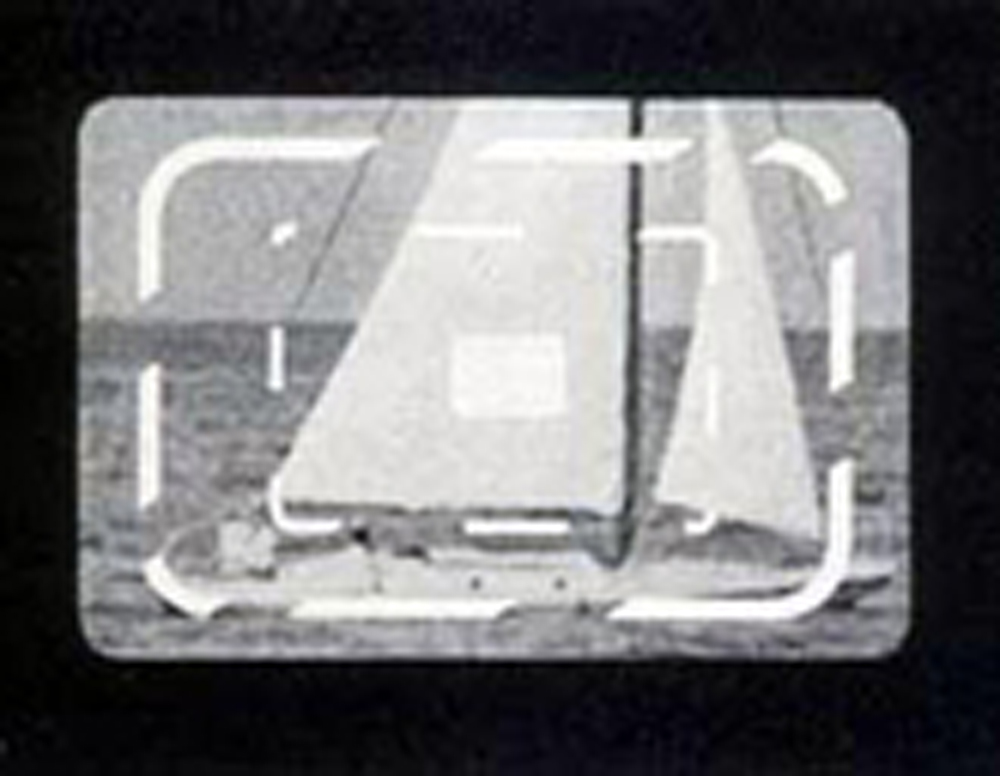
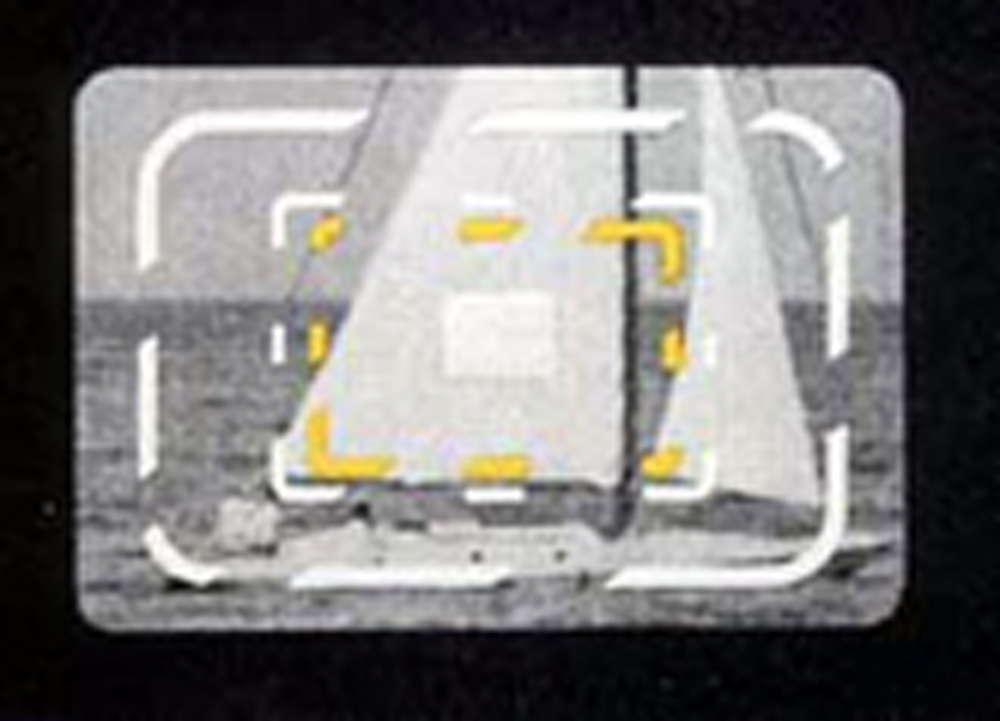
This new camera incorporated a number of new mechanisms:
- 1.The universal finder was incorporated to cope with six interchangeable lenses (2.8, 3.5, 5, 8.5, 10.5, 13.5 cm lenses).
The full-size 1.0x finder, with an automatic parallax correction mechanism for normal and telephoto lenses, and another special finder for wide-angle lenses, were arranged side by side. - 2.The clap and shock of the shutter were made minimal adopting the rear-curtain accelerating device. This was developed for improving the accuracy of the shutter and a silent brake, using the shaft cramping power of a coil was added, to absorb the shock of the shutter.
Incidentally, for the shutter curtain produced after May 1959, titanium (Ti) was used for the first time in the world (later to also be used in the Nikon F) instead of the rubberized cloth ("habutae" silk). - 3.For higher precision and faster flash synchronization, the shutter curtain's traveling speed was increased by 20 % more than that of the S2, and the shutter synchronized at 1/60 sec. with the electronic flash (the Nikon S2 at 1/50 sec.)
- 4.The shutter speed dial settings were equally divided, using a halving (or doubling) progression type, and the dial was a single-pivot, non-rotating type that didn't rotate when the shutter was released. Additionally, it could be coupled with the specially made exposure meter (the Nikon Meter : option).
- 5.Shutter speed settings were colored in green, red and white in accordance with a high, mid and low speed of synchronization (for green, a special fluorescent paint was used for easy identification under dim lighting).
Other features included a dedicated flash synch contact located at the front end of the accessory shoe, the Motor Drive (3 frames per sec.(fps.) possible), and the Finder Illuminator which illuminated the frame of the finder in a dark condition (R6 ("AA") battery built-in), as separate accessories were all directly coupled, eliminating the need of an accessory connecting cord.
This signaled the idea to develop a system camera.
A self-timer was also built-into this camera for the first time in our company.
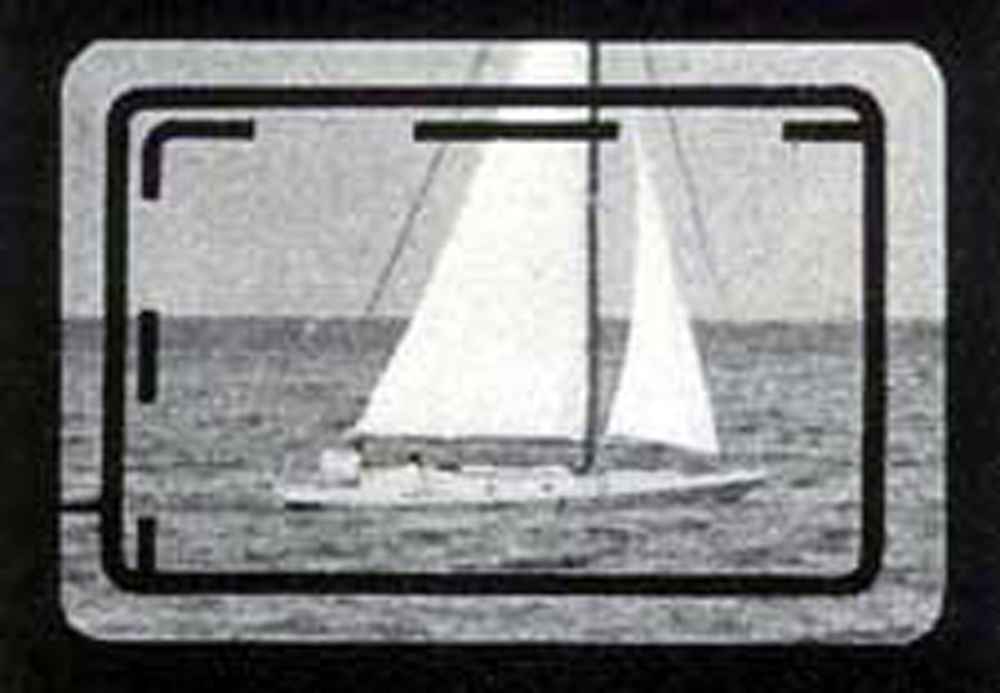
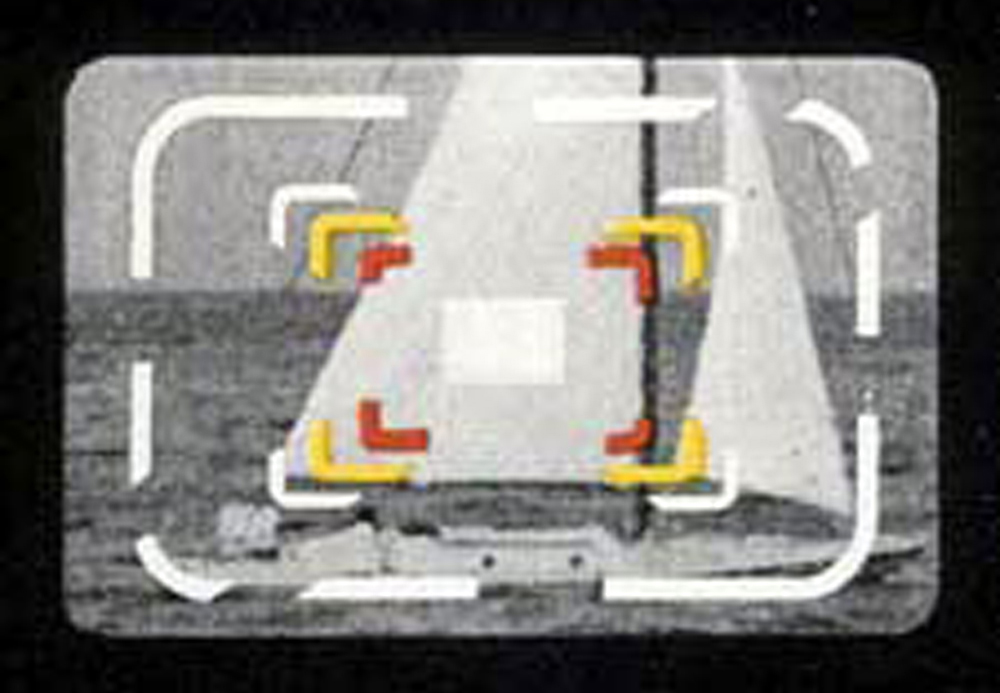
In May, 1957, it was decided that the name of the new camera should be the Nikon SP.
The "P" in SP stood for professional. It was put on the market as the flagship model for professionals.
Release of Nikon SP and Public Reaction
In September 1957, an announcement meeting was held in Chicago first, and then in New York and Tokyo simultaneously in the same month.
The domestic retail price of the camera with the 5cm f/1.4, at the time of its announcement was 98,000- Japanese Yen (with a leather case).
In Japan, in four cities beside Tokyo, an announcement show was held for the press, magazines and camera stores. One of the magazines commented, "A camera which can use various lenses without using special finders was realized for the first time since the Leica M3." ("Shashin Kogyou," "Photographic Industry," if literally translated). The magazine was issued in November 1957.
In the U.S.A., three big photo magazines, "Popular Photography", "Modern Photography," and "U.S. Camera" evaluated the features, including the unique finder mechanism, high-performance focal-plane shutter and Motor Drive, in the same way as when the Nikon S2 appeared.
The NBC network, which broadcasts all over the U.S.A., introduced President NAGAOKA, Masao of Nippon Kogaku K.K. He stood in front of the TV camera with pride declaring, "Japanese cameras have now gained a victory over German cameras."
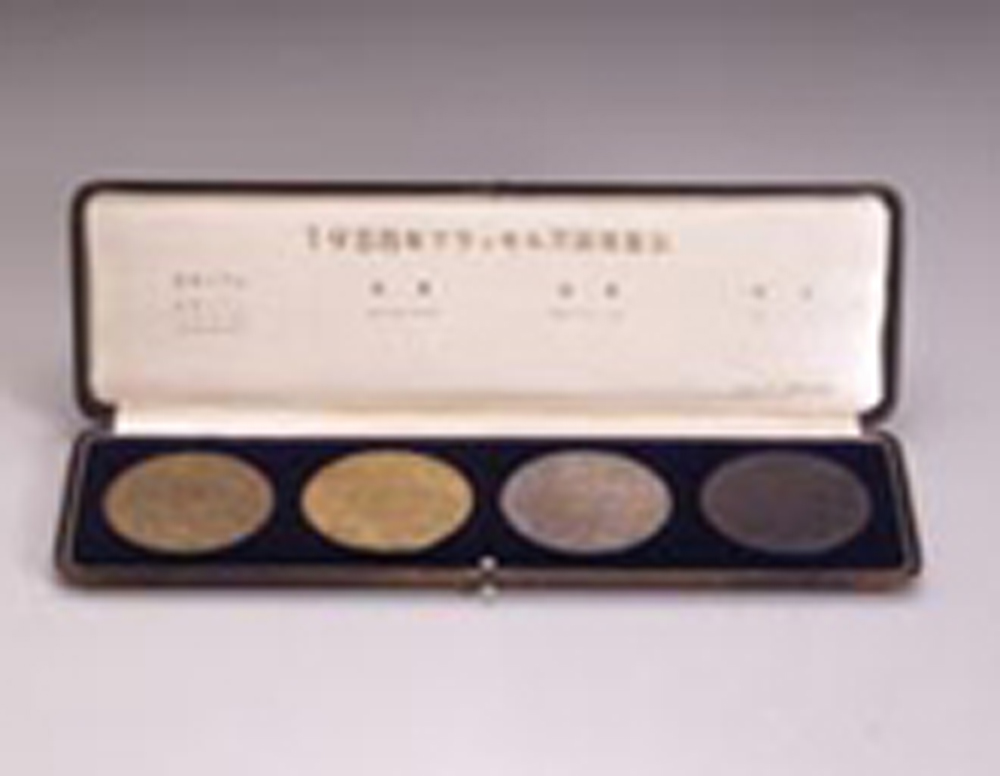
Our company took part in the "Brussels EXPO '58" held from April to October of 1958 in which 40 countries participated. The Nikon SP, as well as Nikkor lenses and optical glass won the Grand Prix*.
- *Beside the Grand Prix, the following products won prizes.
- Gold prize: CINE Nikkor lenses (for cine camera)
- Silver prize: Nikkor lenses for TV camera
- Bronze prize: Nikon Microscopes
Release of Nikon S3 / S4 / S3M
Nikon SP Used Nikon S3 as Springboard to Success
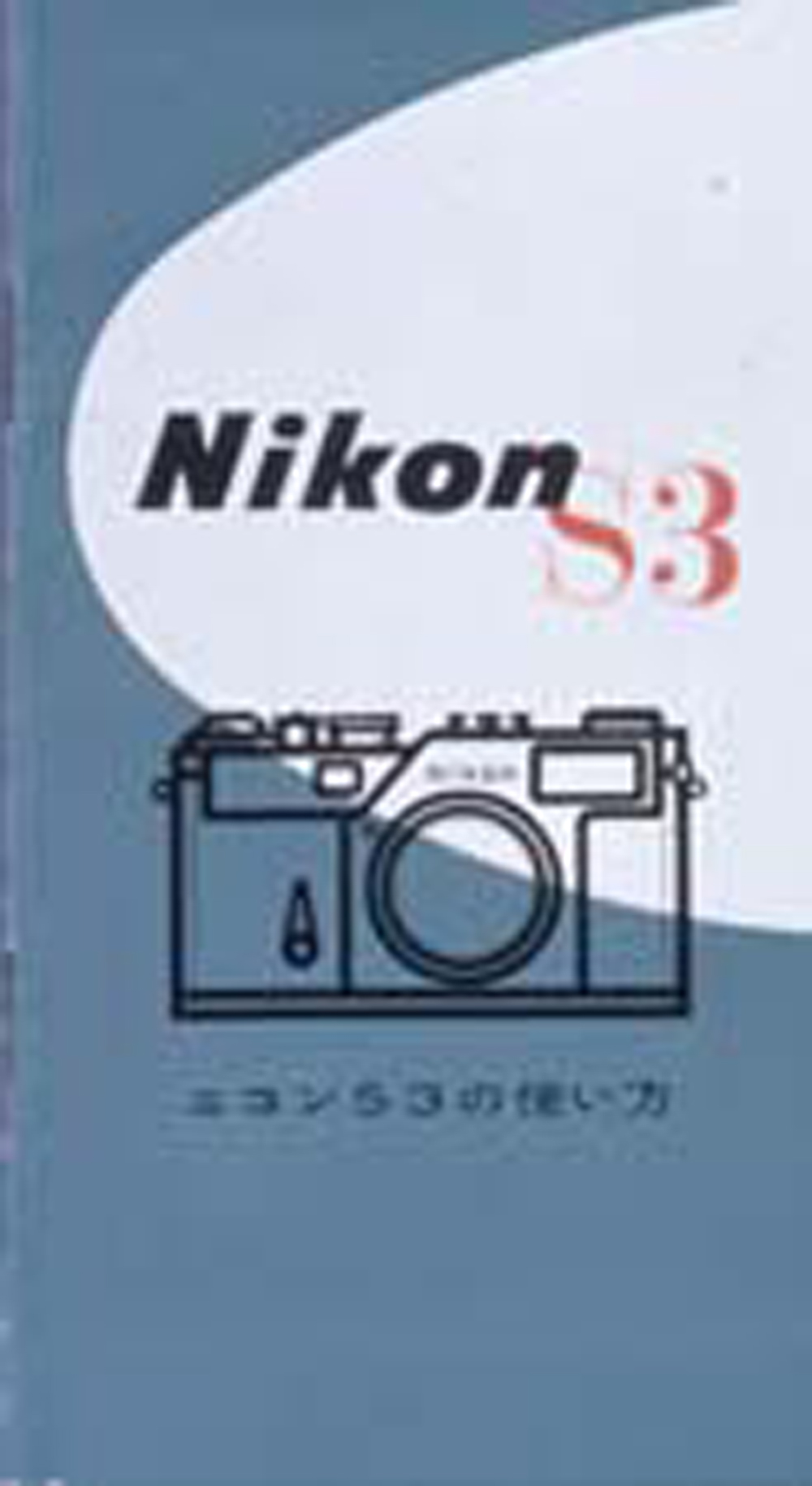
The demand for cameras in the Japanese domestic market increased tremendously owing to the business boom of 1955~1956.
At the height of the depression, after the second half of 1957, many manufacturers sold their products at extraordinarily low prices in order to clear their unsold inventory. However, it was a passing phenomenon and full-scale growth began with the big boom in the second half of 1958.
In the market place, dissemination to the general public was promoted. Each manufacturer produced large quantities of popularly-priced lens-shutter cameras for begining amateurs, thus trying to increase the market share.
Our company released the Nikon S3 in March, 1958 which had been developed in advance of the Nikon SP as a successor to the Nikon S2. This was done to expand the lower end of the high-class camera market, which was beneath the higher-class of the Nikon SP, and in order to increase market share.
The Nikon S3 was almost the same as the Nikon SP, except that the full-size viewfinder was made to cope with three lenses of 3.5, 5, 10.5 cm only, and despite having more advanced functions than "the S2", the domestic retail price was fixed at 86,000- Japanese Yen (with NIKKOR-S.C 5cm f/1.4 and leather case), the same as that of the Nikon S2.
With the release of the Nikon S3, the Nikon S2 completed its mission and was discontinued in June 1958. The aggregate sum of production was a little more than 56,700.
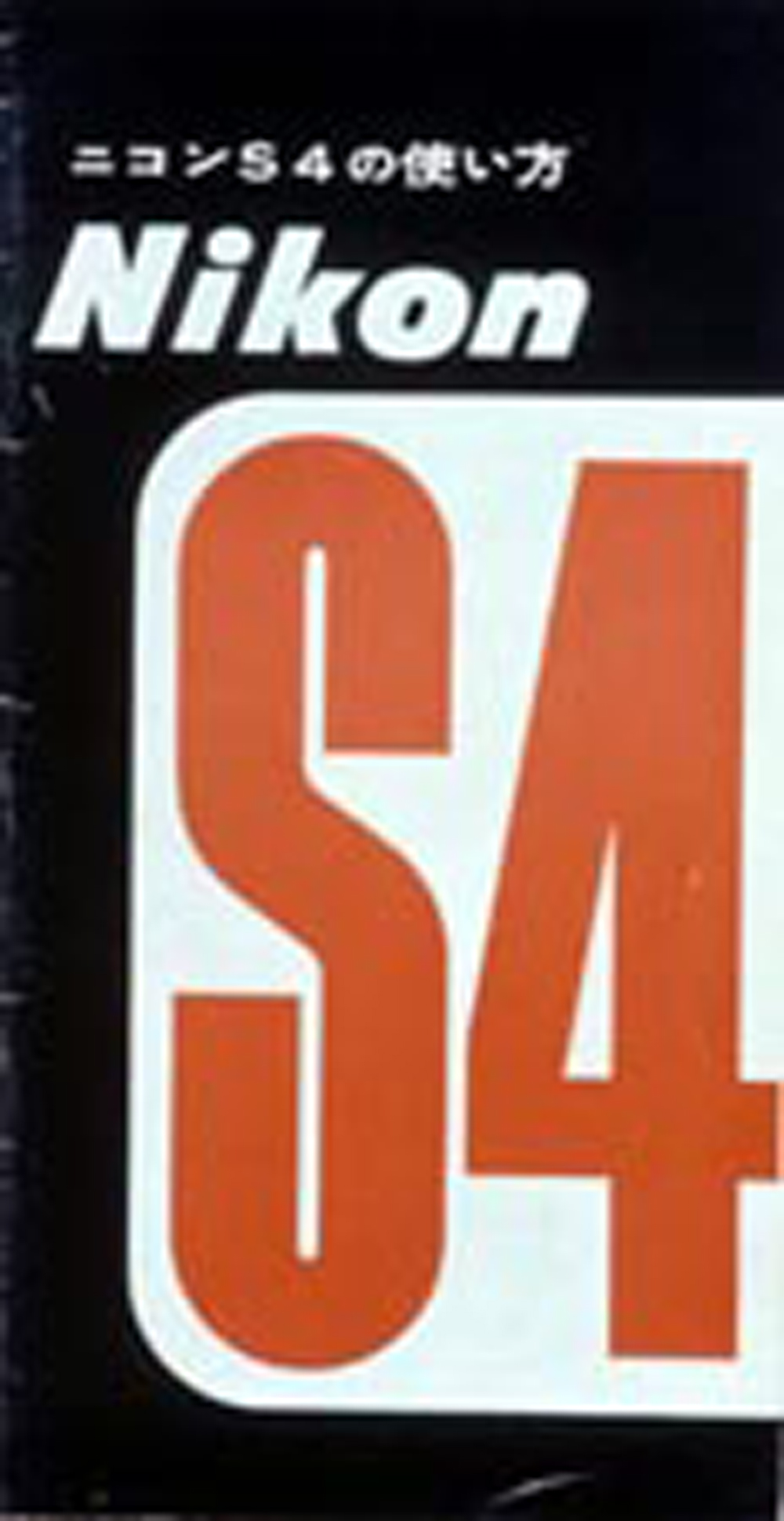
After the release of the Nikon S3, the demand for cameras diversified, due to the rapid increase in the sale of low-priced cameras, and with the appearance of early SLR cameras our high-class rangefinder models were showing signs of slower sales. We took the countermeasure of releasing the Nikon S4 which was the simplified version of the NikonS3, at the domestic retail price of 52,000- Japanese Yen (with the NIKKOR-H.C 5cm f/2 lens and leather case).
It was a low-priced edition which had the finder coping with two lenses of focal length 5 cm and 10.5 cm, and the self-timer and motor drive attaching mechanisms were eliminated.
In the same month, the price for cameras and lenses were revised. The price of the "SP" (with NIKKOR-S.C 5cm f/1.4 and Leather case) was lowered to 85,000- Japanese Yen, that of the Nikon S3 (with the NIKKOR-S.C 5cm f/1.4 and Leather case) to 74,000- Japanese Yen, the reduction rate was about 13 %.
In April, 1960, we released the Nikon S3M which had the picture size of half the 35 mm format of the Nikon S3 (cine size: in the case of the Nikon S3M, 18 mm horizontal and 24 mm vertical) in order to make the speed of the Motor Drive faster.
The Nikon S3M was a half-frame camera to which the Motor Drive could be attached. It could take 4.5 frames per sec. (fps) (7.5V DC) or 6 frames per sec. (9V DC, 9 fps when specially tuned) with the Motor Drive, and could take 72 frames, double that of the normal 35mm full-format (24 x 36 mm) camera.
Suitable for motion analysis photography, including sports photography, this state-of-the-art camera was admired and adopted by news photographers.

Regarding the lens, in 1955, the "lens throw-in method" in which mounting accuracy was maintained by more securely positioning the lens in the lens barrel using a positioning ring.
This method was adopted also for telephoto lenses and the production increased with ease.
In approximately March 1956, we started further lens improvements altogether, by standardizing the outer appearance among lenses, and by using a light alloy material for the lens barrel to reduce lens weight. In September 1956, the number of lenses became eleven (11).
Main Production of Nikon Rangefinder Cameras Ends and Reproduction
The production of rangefinder cameras reached the aggregated sum of 130,000 in 1959, when it was decided that production should be discontinued as the main stream of high-class models shifted to the SLR including the Nikon F.
However, the requests by the press and magazine photographers were strong. Our company coped with the demand by recommending the production of the Nikon SP in May 1964 in limited quantity. This was discontinued in April 1963, with a total of a little more than 21,300.
And in 1965, the "Nikon S3" (with the NIKKOR-S 50 mm f/1.4 lens) was produced, also in a limited quantity of 2,000.
Release of Fisheye Camera
Widening the usage of industrial and photographic lenses
Due to an increase in consumption in Japan and facility investment around 1955 through 1960s, the technology of our company has seen more light and new optical device products and lenses started to join the market.
Industrial lenses have widened its usage.

Indirect X-Ray Photography Device

Indirect X-Ray Photography Device
In 1959, Nippon Kogaku sold Nikkor lenses to Shinkodo (Bronica Corportation, current Tamron Corporation) which made for Zenza Bronica medium format SLR cameras.
In February, 1957, EL-Nikkor 50mm f/2.8 was released as a practical enlargement lens.
The trend of large aperture for Cine-Nikkor 25mm lens, which is a standard lens for 16mm film movie cameras, started after the release of Cine-Nikkor 25mm f/1.4 in September, 1955, and the release of Cine-Nikkor 25mm f/1.2 in March, 1957.
Other lens, such as Fisheye-Nikkor 16.3mm f/8 was developed in March 1957, after an improvement of 16mm f/8 Fisheye lens (1938).
By the way, developing the 16mm f/8 Fisheye lens, which was used by the former Imperial Japanese Navy (IJN) meteorological observation troops. Development of this lense was a tough job because the thickness of the center of the first and second lens, which is the concave Meniscus lens (a concave lens where one side is convex and the other is concave), had to be made very thin.
The Fisheye-Nikkor 16.3mm f/8 used in 120 format camera body of "Indirect X-Ray Photography Device" for "Weather Photography System (Weather Recording System)" can take a monocrome picture of the entire space above the horizon in one frame.
It was used by the Meteorological Agency, The National Defense Academy, and Japan Broadcasting Corporation (NHK), for meteorological observations.
The medium format camera of "Weather Photography System (Weather Recording System)" was later sold as "Fisheye Camera ("Camera with Fisheye-Nikkor lens")" in September 1960, for 200,000 Japanese yen.
Product and company names in this article are trademarks, registered trademarks, or products of their respective owners.
Colors of product photographs on the monitor may differ from the colors of the actual products.
Camera Chronicle
Archives of corporate history subject matter related to Nikon cameras, including rare materials, as well as product photos of cameras and lenses.
